The ALMONDBURIAN
THE MAGAZINE OF THE OLD ALMONDBURIANS’ SOCIETY

(Opposite):
of Holmfirth is by former KJS staff member Christine Hazle who sadly died in March. Her obituary appears on page 63.

THE MAGAZINE OF THE OLD ALMONDBURIANS’ SOCIETY

(Opposite):
of Holmfirth is by former KJS staff member Christine Hazle who sadly died in March. Her obituary appears on page 63.

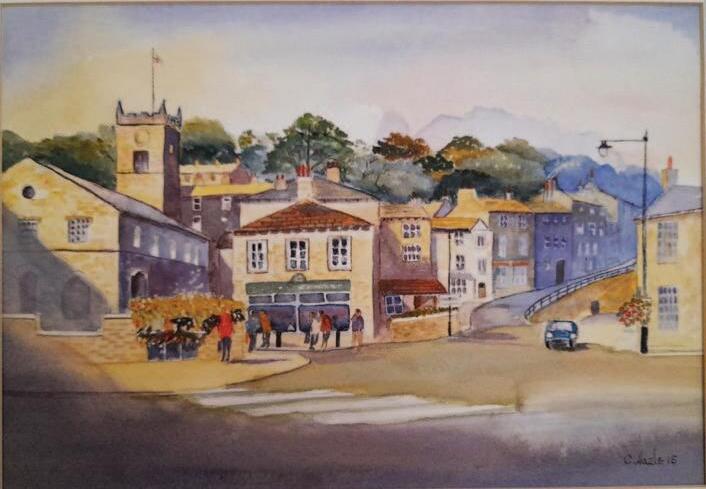
WELCOME to the July issue of The Almondburian. I hope you enjoy it.
A few weeks ago the trustees of the School Foundation were invited to take a look round the new £5 million teaching block (see page 6) before our meeting began. It was a breathtaking experience. the results are stunning and at last the students of King James’s School can look
forward to learning in a working environment fit for purpose in 2022.
The main corridor in the building is wider than many of the classrooms in the older parts of the School and a lift is installed for disabled students and for the moving of chairs and tables. The classrooms at 55 square metres are enormous compared to what retired members of staff had to teach in. I’m sure if any of you
get chance to look round you will be blown away with the quality of the build. Congratulations to the architects and builders but also to Ian Rimmer and his staff who put their ideas forward to help produce not only a wonderful working environment but also a marvellous legacy for the future. And of course, this new facility will be desperately needed now the number on roll at King James’s is an eye-watering 1034!
As reported in previous issues of The Almondburian, we have been working with the Principal to build a seating area round an old yew tree close to where the Big Tree used to be.We were waiting for the completion of the new teaching block and for the ‘temporary’ classrooms to be removed before this project could begin. Unfortunately this was likely to be further delayed as the classrooms will now be used as temporary changing rooms while the present changing rooms in the Sports Hall are upgraded to cater with the larger numbers in School. But there is some unexpected good news: as we report on page 38 there is now a plan to plant a new tree in an alternative clear location not far from the old Big Tree as part of an international initiative launched by Newnham College, Cambridge.
I must add that a donation of £100 was recently sent in by the widow of an OAS member who felt it would be a small but lasting legacy from her husband who had so many happy memories of his time at School. Food for thought.
Linked with the seating project I had an
email and later a phone call from a former student. It was from Ruth Ainley who some of you will remember was in the early intake of the comprehensive school. She is now a Head in a school near Selby. She told me of her happy memories of school and the fact that, as a keen linguist, she was blessed having been taught by Dave Bush for Latin, Dave Gregson for French and Bob Field for German. She thinks she was the first girl from King James’s to go to Oxford. A brilliant achievement.
As a member of the OAS she had read about our seating project and said that her school had similarly lost a large tree and wanted to replace it and have a seating area round it. I put her in touch with Chris West who drew up the plans for our seating. I hope he can help her.
As many of you will know, I was very disappointed last year that we were unable to have the Royal Charter back in School for either the Heritage Weekend or the Founders’ Day Dinner. Roger Dowling met up with the West Yorkshire Archivist who is presently cataloguing our own archive material.They discussed a range of issues but particularly the frustration felt by the Society at its inability to get the Charter back in School for important events. The Archivist, Robert Clegg, suggested we approach the Yorkshire Archaeological Society with a request to take back ownership of the Royal Charter. The Charter would still be kept by the West Yorkshire Archive Service as at present but it would mean we could have the Char-
New teaching block will be a marvellous legacy
ter whenever we wanted it. I spoke with Ian Rimmer, who was keen to support the project and a letter has now been sent to the YAS. I will keep you informed.
In my conversations with Ian, I asked him about the awarding of prizes after the cancellations of numerous Presentation Evenings because of Covid. He informed me that the Governors had decided they would no longer have one large presenting of awards at the Town Hall as had been the case pre-Covid. The leavers would be invited back to school to receive their certificates in October. Any individual prizes would be awarded to them then. Similarly, the rest of the school population would hold a Presentation Evening in school before the Summer Holidays. It
would be an event by invitation for students and their parents to celebrate individual awards and prizes.
Ian was not sure if this would happen this year but may I ask once again that if you are a supporter of school and sponsor a prize you may think of sending the value of your prize to the OAS who will add it to the seating project fund.
After the success of last year’s Dinner I ask you all to put the date of this year’s Dinner in your diary. It is Saturday, 26th November. I am pleased to inform you that your Executive Committee have invited Professor Edward Royle and Jackie Hart OBE, née Chilvers, to speak at the Dinner and both have kindly accepted (see page 8). n
FOLLOWING his victory in this year’s Gothard Cup competition (report: page 58), we have been delighted to welcome Mark Slater (1976-81) as a member of the Society.
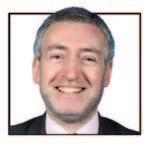
Sadly, since the publication of the last magazine, we have learned of the deaths of two members: Christine Hazel (obituary: page 63), who was a member of staff from 1976 until 1999 and Peter Sykes (1959-64) from Kirkheaton.
For the few members who do not pay their subscriptions by standing order, please remember that your £10.00 subscription for 2021-2022 fell
due on 1st September last year. Thank you to those who have recently brought their subscription up to date; however, if you do receive a letter with this magazine pointing out that your subscription is not up to date, please do send your payment without delay.
It does make life much easier if you can complete the updated standing order mandate that accompanies the letter and return it in the envelope provided.
Alternatively, you may renew online, using PayPal or a debit or credit card, by visiting www.oas.org.uk and clicking on the ‘Join/Renew Online’ button.
After two very long years, life is slowly returning to normal, reports Ian Rimmer. It’s been a battle of endurance.
IT was once said, “Some of the world’s greatest feats were accomplished by people not smart enough to know they were impossible.” I have never claimed to be the greatest intellect, but I guess I must now fall firmly into the ‘not smart enough’ category, else I may never have undertaken such an all-consuming challenge.
The past two years have felt very much like a battle of endurance against several elements: Covid, integrating students from Almondbury Community School, working across a split-site and undergoing nearly £5 million of internal re-development and a new-build construction. Surely, only a fool
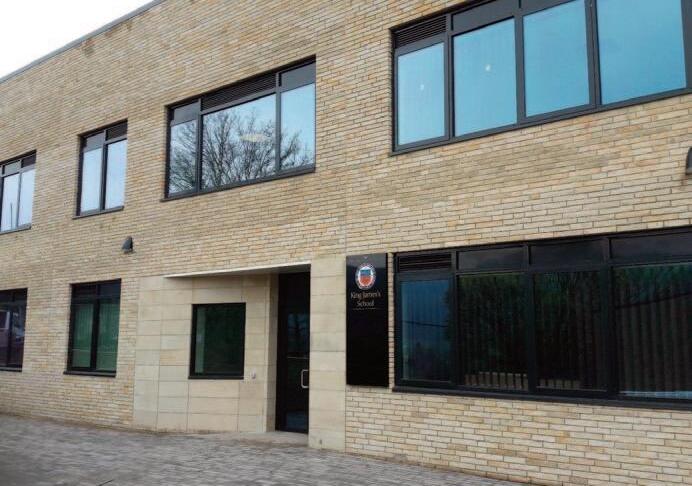

would take on such a challenge willingly. In my defence, I was not aware of the oncoming pandemic; the rest is sadly down to me!
It would be foolish to suggest that the pandemic is done with, but certainly many of the time-consuming routines of testing and vaccination seem to be a welcome thing of the past. We can also, now, try to restore some of our old routines; the extra-curricular programme has been particularly badly hit. Students behaviour has also been noticeably adversely affected; I am sure many Educational Psychologists will be feasting of this for years to come. Breaks of routine are particularly damaging to mental health and
good conduct. But many parents have struggled too, which in turn has added to stresses at school. I cannot conclude this section without referencing the impact of the past two years on staff, who have kept the ship afloat under remarkably difficult circumstance. To them I am hugely indebted.
With regards to the internal development, as previously reported, the dining hall has been extended internally and externally, we have a new Science lab and two new routes around school, which are critical to aid student flow with an increased student population, now approaching 1050.
And so to the new block, which was finally completed and handed over to the school during the Easter holidays. In fact, the keys were signed over to colleagues as I was completing my 96-mile walk along Hadrian’s Wall; perhaps I am a glutton for these seemingly impossible challenges. We now have an additional 10 classrooms, four offices and two new sets of toilets; the block is the new home for English and Modern Foreign Languages.
And with the new block came theYear 8 students who have spent the last 18 months at Fernside, the home of the former Almondbury Community School.They are integrating really well, aided to a large extent by a comprehensive transition programme that was put in place to ease their move down to St Helen’s Gate. So, we are finally all on one site; only seven months later than expected!
So, is life back to normal now? Well, that’s perhaps a little premature, but we are certainly hoping so. GCSEs are taking place this year for the first time since 2019 – a welcome return. Yes, most children do actually like to take exams as external verification and acknowledgement of all their hard work.
We are also now turning our eye to the future. A larger intake from a changing demographic will provide the School with new challenges. But with new challenges come new opportunities, be they possible or otherwise! But perhaps I am not smart enough to know what is impossible! n
l Top sets in Years 9, 10 and 11 took part in the UK Mathematics Trust’s Intermediate Mathematical Challenge, run by the University of Leeds.They gained an impressive 36 Bronze Certificates, 8 Silver Certificates and 5 Gold Certificates.
l As part of theYoungWriters ‘Myths and Legends’ Scheme of Learning in English,Year 7 students took part successfully in a ‘Twisted Tales’ creative writing competition. Students were tasked with flipping the narrative and writing from a villain’s point of view.
l Staff and students raised over £600 in a Bake for Ukraine event. They baked buns and biscuits to show support and to raise funds for the men, women and children of Ukraine following the Russian invasion.
l KJS students took part in the Kirklees World Book Day Quiz, organised by BooksPlus (Kirklees Schools Library Service), an annual reading quiz that has been running since 2013.

THIS year’s Annual Dinner will be held at the School on Saturday, 26th November , at 6.30 pm for 7.30 pm. The principal speakers will be Jacqueline Hart OBE (1976-81) and Prof Edward Royle (1955-62).
The ticket price this year will be £32.50 and an application form for tickets is included with this issue of the magazine. Alternatively, you can purchase tickets online at www.oas.org.uk/buydinner.php. Please be aware that when the Annual Dinner is held at the School
places are limited, so early applications are recommended.
It is always good to see members making a special effort to stage a re-union of their year at the dinner and such occasions are always enjoyable, so those with a special anniversary this year, members of the classes of 1947, 1952, 1962, 1972, 1982, 1992, 1997, 2002 or 2012 for example or, indeed, anyone else who takes a notion to do so, should consider starting to organise their class reunion earlier rather than later.
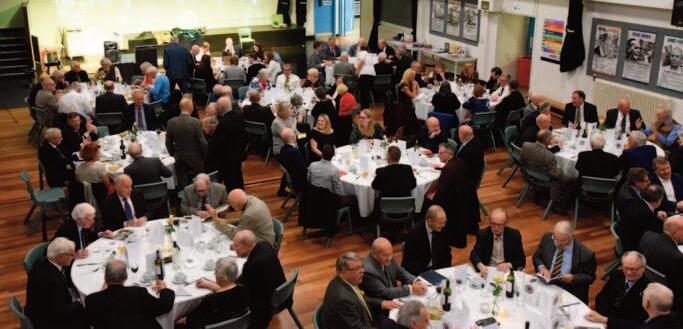
Founders’ Day
Following the success of last year’s Friday-afternoon Founders’ Day Service, this year’s Service be held on the afternoon of Friday, 25th November at All Hallows’ Church, Almondbury. The procession up St Helen’s Gate will leave the School at 2.00 pm.

EDWARD ROYLE benefited from King James’s historic charter in that he came to the School from Linthwaite township in the ancient parish of Almondbury as a foundation scholar in 1955.

He went on to Cambridge to read history in 1962, remaining there to complete his PhD in 1968 and then to become a fellow of Selwyn College. In 1972 he moved to the history department at York where he remained until retirement in 2004, having risen through the ranks from lecturer to professor, serving time along the way as head of department. He is now Emeritus Professor at York. He has published widely on the social and religious history of Britain since the eighteenth century, with a special interest in the local history of Yorkshire.
JACKIE HART was a member of the first Comprehensive intake in 1976 when she was 13. She took ‘A’ levels in French, English and History before leaving in 1981 to graduate in Social and Economic History at Nottingham University.

On leaving university she joined the Civil Service and had various roles in Police Department Policy, Prison Service Security and Criminal Policy.
In 2001, after various roles in the Home Office, Jackie became Senior HR Business Partner in the Department for Business. She became Head of HR for UK Trade and Investment (UKTI) in 2013 and when the new Department for International Trade (DIT) was formed in 2016 she took on her present role as HR Deputy Director.
The pandemic may be largely over, but assistant principal Abbi Terry believes that the long term effects will be farreaching in terms of staff and student mental health.

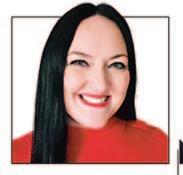
IT is hard to believe that two years ago we were caught up in a pandemic and KJS staff were holding the fort. My role during this time was coordinating the students who were in School. There were very strict rules that we had to follow in terms of who could come in and I was in constant contact with parents organising all this.
Some parents were not happy. They had important jobs and occupied important roles but all of a sudden, they were not classed as ‘essential workers’. I remember clearly, one Sunday evening, sitting in my living room with my husband and daughters watching TV. At the same time, I was online receiv ing a barrage of emails from disappointed parents because we could not allow their children to be in School. Over and over again I had to explain that I didn’t make the rules and I was simply following them. Some parents threatened to report me to the School governors while oth ers threatened to go to the Department for Education. Safe to say, it was a tough time and morale was at an all-time low.
And now, two years later, it is almost
like nothing has happened. Or is it?
Even though the lockdowns may be a dim and distant memory, I fear that the after effects of the pandemic will be far reaching and long lasting. I am currently training to be the Senior Mental Health Lead at King James’s School and am desperately worried about the future and what it might bring both for staff and students.
Many staff are struggling.This isn’t something exclusive to KJS – it is a national issue. In a National Association of Schoolmasters Union of Women Teachers (NASUWT) survey of 4,000 teachers, 84% stated that their mental health has been impacted and is it any wonder?
Over the last two years, staff in education have had to continue working face to face during a pandemic, and they have had to update practice and follow rules published for schools at a moment’s notice. Quite often we found out about updates to running a school during Covid 19 through the media and not through the official channels.
As well as this, we also had our day job of teaching! Some believe that staff in schools had it easy because there were no students in
school – this is far from it! We had to juggle teaching the ones in school while teaching students at home as well. Many of us also became unqualified counsellors as we maintained contact with our families to check in with them. Our pastoral staff spent a lot of time sourcing food banks and emergency support for issues such as domestic violence and homelessness. Believe me – it was complicated and heartbreaking.
As well as burn out, stress and teaching, many staff had to continue working face to face while being desperately worried about their own vulnerable family members and concerned that they were putting them at risk. This is not something that people can just get over.
In terms of students, I fear that we are going to continue to struggle with
the rise of mental health issues such as anxiety, depression and self-harm. Waiting lists for professional help for our young people are at an all time high. NHS figures show that 420,000 under 18’s were either having treatment or waiting for treatment for mental health issues and that there has been a 54% rise in young people needing help since 2020. The Mental Health Foundation state that 75% of children and young people who experience a mental health problem aren’t getting the help they need. The charity – Young Minds – has referred to this as an ‘unprecedented crisis’.
I worry about the King James’s community and their health and wellbeing and even though the pandemic may be ‘over’ – I fear our biggest battle is ahead. n
Friday, 25th November 2022: see page 8
ANNUAL DINNER
Saturday, 26th November 2022: see page 8
BADMINTON/TENNIS: see page 57
GOLF (GOTHARD CUP): report on page 58
Executive Committee meetings are usually held on the first Monday of the month, although there is no meeting in August.
They are currently being held at 6.00 pm in the ODH at School with a Zoom link for those unable to attend in person. Any member of the Society who would like to attend one of these meetings will be made most welcome on the following dates:
Monday, 4th July
Monday, 5th September
Monday, 3rd October
Monday, 7th November
Monday, 5th December
If you would like to join us for any of the above meetings and are unable to attend in person, then please e-mail the secretary at andrew.haigh@oas.org.uk to request login details, an agenda and any other documents.
Old Almondburian David Morphet publishes his latest collection of poems which evoke the intense colour and vitality of the Cyclades
DAVID Morphet’s latest volume of poems, Ring of Islands , celebrates his love of the Cyclades in the Aegean Sea. All but one (Ano Syros) of the twenty-five poems have already appeared in various collections between 2012-20, and this volume brings them all together for the first time. Two of them, the first and last, are translated into Greek by a friend. Morphet says in a preface that “the poems seek to evoke the intense colour and vitality of the Cyclades” –or, in the words of the first poem, to celebrate
A ring of islands which unites shrine and saint with rock and sea.
(A ring of islands)
Thus many of the poems describe experiences on particular islands. Some will be familiar to any tourist:
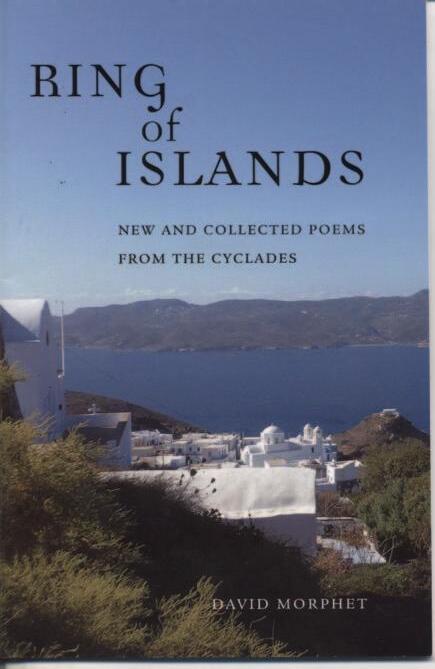
It’s dusk in Naxos and along the quay candles flicker on the cafe tables. Waiters lure and hustle passers-by with a flourish of their establishment’s all-too-predictable katálogos:
moussaka and stifado and souvlaki.
(Dusk in Naxos)
The natural beauty of the islands is celebrated:
From here, look far. On a summer’s day you’ll glory at unclouded sky cohabiting with isle-strewn sea. You’ll breathe the charismatic air.
(Ano Syros)
The maps that matter now are in the mind. Imagination’s the most useful baggage.
(Finding the way)
Altogether this collection portrays these islands from an informed visitor’s perspective, loving but discerning, trying to place experiences felt here in the context of his wider life. Thus general reflections come through at times, as when an observation of the ordinariness of island ferries turns into a thought about what everyday life does to youthful hope:
There’s no romance in their discharge of trucks and spew of jostling passengers. Dreams of sailing to Delos with a cargo of apes and ivory can be put on hold.
But while affectionate the portrait is far from idealised:
At noon the air is dense with sun. It thickens by the quay in brine. At dusk it seeps around the town reeking of cat and gasoline.
(Island air)
However, readers of Morphet know to expect more than just a travel guide. For the Naxos poem quoted above ends:
…all the widows and the waiters know that thread of summer can wear thin and, in a colder season, may unravel.
(Dusk in Naxos)
‘Widows and waiters’ both know how good times can come to an end, not just on Naxos. And any independent voyager will recognise the feeling of
(Metaphoric ferries)
But the overall tone of the collection is appreciative and hopeful, and the last words the reader is left with are an encouragement to keep hoping: The next island’s never far away. Its ridges scribble the horizon with reasons to go on.
Consult your travel guide on this. Consult the Odyssey.
(Envoi: the next island) n

New and Collected Poems from the Cyclades
David Morphet
40pp 130 mm x 200 mm
Price: £5
Spotters: John Bradley, James Clayton, Roger Dowling
Have you spotted anything in print or on social media that has amused you or given you food for thought? If it’s worth sharing, send it to us at spotters@oas.org.uk.
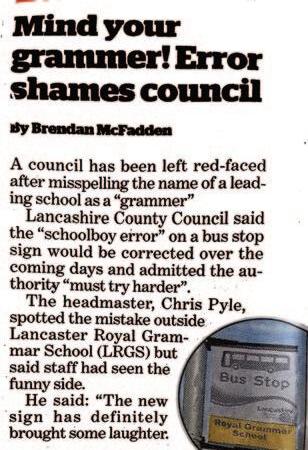
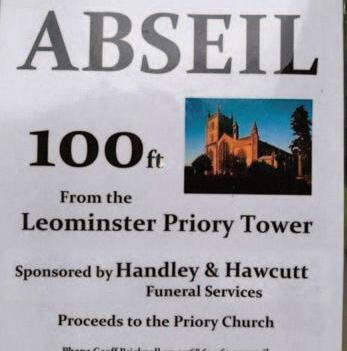


ENGLISH AS SHE IS SPOKE

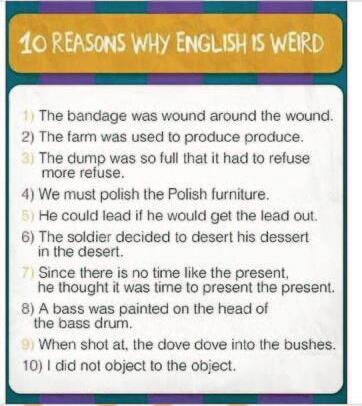
Everyone, it seems, has a view on the BBC.

The licence fee is an outrageous regressive tax on working people. Its presenters and newsreaders are paid ridiculous salaries. Its news bulletins are biased. Its programmes are rubbish.
But despite the brickbats 11 million viewers watched the final of last year’s Strictly Come Dancing, 34 million listeners tune in to BBC Radio each week and the BBC iPlayer is enjoying record viewing figures.
Four Almondburians ended up, through no fault of their own, in the BBC. This is their account of how they got there and what it was like.
Andrew Taylor Journalist/Reporter
Jonathan Barton Journalist/Editor
Gorden Kaye Comic actor
Roger Dowling Engineer/Manager
NOTHING is crueller than technology. And broadcasting is nothing without it.

I arrived at Television Centre from Fleet Street, where the only tools of my trade had been a notebook, a pencil, and a degree of shamelessness, low cunning and borderline dishonesty that would have shocked my parents. The nearest I came to technology was putting 10p into the phone to dictate my copy to the office. (What? Oh, Google it, or go and ask your grandad.)
And now – or rather, back in 1980 –I was joining the BBC at the start of a technological revolution. Video cameras that produced instant pictures as if by magic, rather than film that had to be developed in a darkroom and cut up with a razor were making everything faster, more reliable. ENG – electronic newsgathering – was the wonder of the age. I was the first reporter in the place who had never used film.
Now, of course, those same cameras, lugged around on the shoulder of a longsuffering cameraman, followed by a soundman who carried the recorder bouncing on his hip and scowled at anyone who spoke while the camera was
running, have been shipped off in their turn to the museums. (And they were almost exclusively men in those benighted days. One of the more welcome changes is that the whole industry is much more gender-blind than it used to be.) Turn your back on technology for a moment, or in my case for 20 years, and it has a habit of changing. But those first months at the BBC, learning new techniques, new skills, new ways of telling stories, were among the most exciting of my working life.
I was lucky, too, to meet another Almondburian who could help me. A month or so after I joined, I was drinking coffee at two in the morning in the middle of a long and tedious nightshift with a cameraman whose accent made me feel at home. ‘Where are you from?’ I asked.
“Huddersfield.”
“Where did you go to school?”
TAYLOR worked at the BBC from 19801988. After university, he had worked as junior reporter at the Yorkshire Evening Post. He subsequently moved to the Press Association and then the Daily Express, before moving to the BBC as a journalist and reporter in Television News. On leaving the BBC, he worked for Dubai TV before becoming a freelance writer in 2006. He is the author of numerous books.
“Almondbury Grammar School. Why do you ask?”
“I was there too.”
He grinned. “A bit after me, probably.” There were still people around in those days who were slightly older than I was.
“Maybe. But you might have been there in my dad’s time.”
He looked a bit shocked – he wasn’t that old – until I explained that my father was the Headmaster for more than twenty years from 1951. And indeed my new friend had been at King James’s during the fifties – Richard Hill, one of the best and most respected cameramen in the Corporation.
The fact is – as with most technology – it’s the people you don’t see rather than the people you do who make everything work. To their faces, the onscreen reporters and correspondents used to be called – with a degree of irony – the Talent. But behind their backs they were more rudely referred to as Gob-on-a-Stick. Any television journalist who doesn’t admit that they’ve been saved by a camera operator from looking like a fool has either been too stupid to notice, or is fibbing. Dick and his colleagues helped me more often than it’s comfortable to remember.
The first lesson any reporter learns, and maybe the most important, is that however important you are, however talented, however good looking, however exceptional in every way, your main job when out filming is to carry the tripod. I know correspondents – famous names – who learned this lesson by walking half a mile down a footpath with a camera crew only to have the camera operator turn and ask “Where are the sticks?” and when the sticks –the tripod – weren’t forthcoming, silently hand over his car keys so that the unfortunate reporter could hike back to the car and fetch them.
You don’t make that mistake twice,
‘DICK’ HILL, son of a professional photographer at Brook Motors, was at Almondbury Grammar School from 1953 to 1959.
Dick’s career at the BBC took him from Argentina during the Falklands War to Tienanman Square in Beijing to the fall of the Berlin Wall. He was injured by shrapnel in Beirut, and in India he took the footage of a wistful Princess Diana in front of the Taj Mahal that went around the world. He died in 2021.
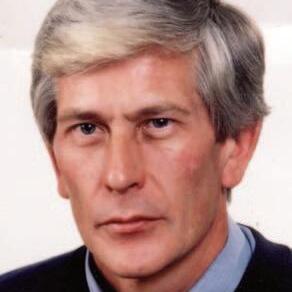
but I was lucky: Dick tipped me the wink.
Or there was the time when I was getting angry because an overzealous policeman had spoiled a good shot by putting his hand over the lens and pushing it – and Dick’s head – back and up into the air. I was so cross that I might have got myself arrested, but Dick calmed me down. ‘I’ll explain later,’ he said.
And back at TV Centre, he showed me the footage – an ordinary, uninteresting shot of people milling around, onto which a black gloved hand sud -

denly thrust itself so that the image was impressively framed between the policeman’s fingers before being dramatically pushed away. What might otherwise have been a pretty boring shot caught the viewer’s eye – not least, that of the police PR department, who told me afterwards that the officer in question had been given some advice about his future conduct, closely followed by a size 11 police boot.
Back in those days, television was a team sport – in fact, as I found out quite recently, in many ways it still is. There was nothing then more fun, or more productive, than being away from the office on a story that was having everything flung at it – reporter, producer, specialists to work the camera, the sound recorder, and the lighting; a picture ed itor, and a dispatch rider to carry the video tapes to the engineer at a mobile radio links vehicle who would transmit the office.
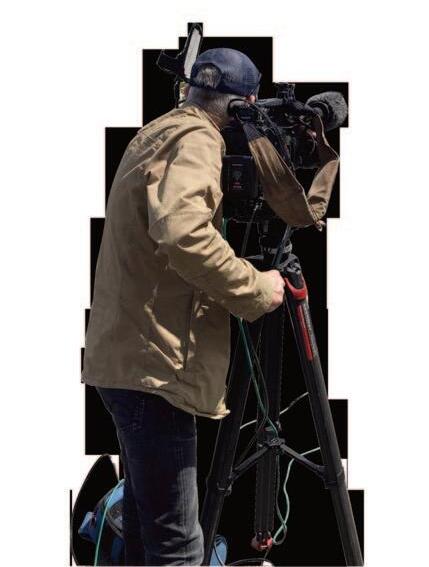
When the day’s work was done, we would all sit round over din ner in some pub, and talk over the story. Everyone would have an angle, a sug gestion, and as a re sult the next day’s coverage would be the best it could possibly be.
All that’s in the past – swallowed up by budget cuts,

technological advances that mean a single person can combine the role of reporter and all the technical jobs as well, and most of all by the demands of 24hour rolling news. When I was working, the world stopped with the closing titles of the Ten O’Clock (or rather, in my day, the Nine O’Clock) News. A story had to be pretty special to force its way on air before Breakfast Time at 6.00 the next morning, by which time it was probably another team’s problem anyway.
I’m not speaking here as some old buffer who thinks everything was better in his day. (Well, I suppose I am –but let me offer a word for the defence and a plea of mitigation.) For a start, these video journalists who do all the jobs at once, like a one-man band strumming a guitar and playing a mouth organ while banging a drum with their knees, have skills and talents I never even dreamed of. A journalist on their own, with a camera the size of a mobile phone, can get into places and film more discreetly than the most determined team could ever manage. Just think of the astonishing pieces of secret camera work or investigative pieces that are commonplace on today’s news. No one’s in favour of wasting money, especially when bashing the BBC is a government sport – so cuts in the size of news teams were bound to come. The only grumble I have is that the cuts are always presented
as cost-free: “The camera operator can do the lighting”, for instance. Of course they can, and of course it will save money, but the end prod uct won’t be of quite such good qual ity.
There’s no doubt either that rolling news is a good thing, with its constant round-the-clock deadlines. And even if it wasn’t, it’s the way the news business is – people want their news to be faster and more immediate, and that means there’s seldom time for relaxed suppers talking about the next day’s coverage.
So things have changed, which is hardly a surprise. But I did, just a few months ago, have an interesting return to the world I once knew. An email from someone I’d never heard of asked if I was Andrew Taylor, and if I had once worked for the BBC. My first response, of course, was to deny everything, then to blame my brother, (always a useful tactic) but then I reckoned that after all these years they couldn’t pin anything much on me, so I said yes.
It turned out that an independent production company was working for Sky Crime to cover the Jeremy Bamber murder case that I’d reported on for
the BBC about thirty years ago. I could hardly deny it, since they had footage of a younger version of me, with hair, no wrinkles, and an annoyingly confident demeanour, telling the world what had happened at the farmhouse behind me.
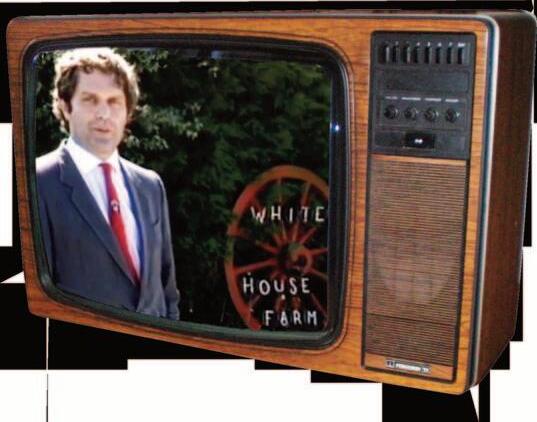
So the team turned up at my house one morning, and we spent a whole day talking on camera about what had happened, how I felt about it with hindsight, what I’d said, and what I might have said differently – a fairly unsettling experience three decades on. Because they were making a documentary series rather than a news item, they had a camera operator, and a sound recordist, and a lighting engineer. There was a producer and an assistant producer, and even a debrief in the pub afterwards.
It was, in short, quite like old times. And watching the eventual series some weeks later seemed like a good way to say goodbye to BBC Television news.


I’D never thought of being a journalist. After nine years I still loved teaching, especially in my last school on the slopes of Kilimanjaro. But we knew the family should return home. Was that a chance also to learn a new trade? Why not journalism?
Back home we could survive financially for three months. I pestered every local radio station within reach. No bites, until a grumpy news editor phoned. Radio Derby faced a staffing crisis. He’d try me out on £60 a week, though didn’t sound keen. Now I had a toe-hold at the bottom of a formidable cliff-face. My BBC education began.
team who really believed in digging out the truth. Local journalism is real journalism. You must find the stories yourself and check every fact.
Lesson 1: Relish your ignorance – and learn fast
I spent four happy years there, reporting, making documentaries and running an allspeech breakfast show. Some of the best fun was launching BarbedWireless, a nightly youth show nicknamed by a London boss “Punk Radio 4”. The first Thatcher recession put thousands of young people on the dole.We wanted to empower them and showcase their music. Our presenter was Terry Christian, a bright, bolshie 20-year-old with no broadcast experience. I recruited a large team of contributors from local schools and youth groups.
Yet I loved it all, the adrenaline, the non-stop turnover of stories, editing tape with sticky tape and razor-blade, constantly meeting new people. Above all, slowly winning the respect of a
Newsrooms are frenetic. Deadlines every hour. Scripts to be typed perfectly first time. Being shouted at if you make mistakes. After a week in the newsroom I raced back on my motorbike from a ghastly motorway pile-up. With 10 minutes to spare, the lunchtime presenter listened to my tape, threw it back at me screaming, “This is absolute crap – our lead story – it can’t be broadcast!” I had a lot to learn.
BARTON worked at the BBC from 1980-2000. His career started as a BBC local radio journalist but later moved on to TV Current Affairs on The Money Programme, Breakfast Time and Six O’Clock News. After six years on Newsnight as assistant editor and later acting editor, he became editor of BBC1’s One and Six O’Clock news programmes. From 1997 he edited Radio 4’s Today. Jon left the BBC in 2000 after opposing controversial management changes.
Our noisy, controversial show was a BBC first and later won two national Sony Awards. But its first night could have ended my career. We launched with a star line-up, including clean-up TV campaigner
MaryWhitehouse and the BBC’s master interrogator, Sir Robin Day, plus two top bands, UB40 and The Beat.
Terry interviewed UB40 in Birmingham at lunchtime. I’d warned him that any broadcast of the “f” word would get us
January 1997: Jon Barton, new Editor of the BBC Today programme.The photographs on the wall show four legendary past-presenters: Jim Naughtie, John Humphreys, Sue MacGregor and Brian Redhead
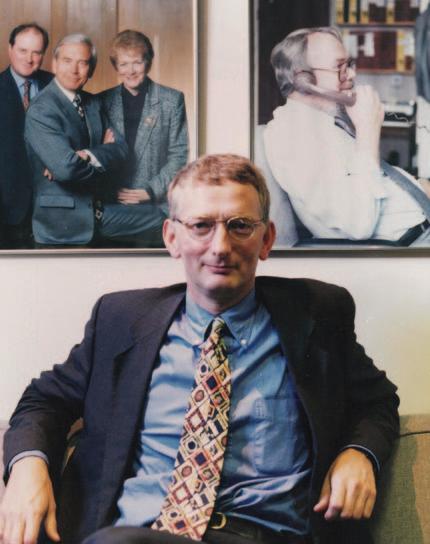
sacked. I checked his tape and chopped out an amazing number of “f” words. Later, when The Beat went live, I gestured helplessly at Terry through the glass as a sequence of “f” words sounded loud and clear to households across the East Midlands.
When the show ended I felt immensely proud of our rookie team, but knew I’d be for the high-jump.The Station Manager phoned. He was brief. “That was a very… interesting… programme, Jon. Do pass on my congratulations to everyone.”
That night he taught me something important about leadership. He’d taken a huge risk commissioning BarbedWireless. He knew we’d screw up at some stage, but trusted us to learn lessons from our failures.Which we did in the hundreds of editions which followed.
Lesson 2: Innovative programmes need brave and trusting managers
Radio Derby was a great place to experiment. But TV tempted me with an attachment to the legendary Lime Grove TV Studios, to work on Sixty Minutes, the shambolic teatime successor to Nationwide

At reception no-one had heard of a Jon Barton joining the team.Yet two days later I was told to produce an item on the impact of dropping Agent Orange on Vietnam. For
some reason the film clip I’d chosen of poison canisters dropping from bombers was broadcast backwards. Seven million viewers saw big barrels float up from a jungle to land neatly inside an aircraft. I was congratulated on my first TV piece. No-one had noticed. No-one seemed to care.
Unsurprisingly the programme was axed. I was offered refuge on the Money Programme. But first, during its summer break I’d work on the new Breakfast Time, with its fizzy mix of hard news, entertainment and glamour. Our boss was a tough Glaswegian. Ron Neil worked us hard – overnight shifts were 16 hours long – but he insisted we should love every minute of it. And we did. It was like belonging to a massive, sprawling family, led by a benign Mafia boss. Millions of viewers loved the UK’s first ever
breakfast TV show and the BBC’s biggest success in years.

Lesson 3: Fun and fine journalism sit happily together
Then, after an inspiring season where I pretended to understand economics on the Money Programme, Ron – now Head of BBC News – strong-armed me to move to his radically reshaped Six O’Clock News at TV Centre. They called us “the lost tribe of Lime Grove” – current affairs folk reluctantly transported to the TV newsroom.
The Six was Britain’s most popular TV News. Ron wanted it to be also the most ambitious. He believed we should have the skills to fascinate teatime viewers with nuclear physics or Shia theology if that’s what viewers needed explaining. He was a man with a mission.
He’d materialise behind me, squeeze my shoulders and in broad Glaswegian boom out his mantra: “Go on, laddie, surprise me!” It always inspired a twinge of terror. But I loved the daily challenge of making “quick invasions of great subjects”. At 6.30 we’d troop into his office for a post mortem. If we’d messed up he’d ask how we’d avoid it next time, then smile wisely at his laddies and
Breakfast Time: the UK’s television's first national breakfast television programme was launched in January 1983. Presenters included (front): Frank Bough, Selina Scott, Nick Ross; (back) Francis Wilson, Debbie Rix, David Icke.
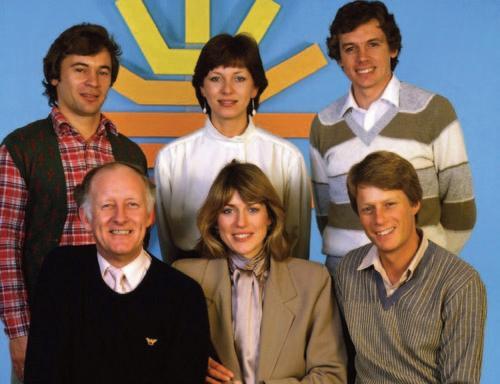
lassies and say “No worries. Remember tomorrow is another day”.
I just loved it, so when asked to join Newsnight as assistant editor I said no. BBC bosses don’t take no for an answer…and so began six crazy, wonderful years..
Lesson 4: Never underestimate your audience. Go on, surprise them!
I quickly felt at home with my nicely eccentric new colleagues. I’d sit at 7 o’clock in an empty office and think: in 15 hours’ time, what vital questions of the day will still be unanswered? How can we turn it into entertaining TV which keeps 1.5 million people away from their beds?
I could bore you with a long catalogue of unforgettable experiences from those years. Huge stories breaking as we went on air. Over-the-top studio specials on key issues. Broadcasting live from history-making events. Grabbing a brick from the first breach in the Berlin Wall and rushing to an East Berlin studio to astonish Peter Snow, his guests and viewers back home. I was a very lucky man.
We prided ourselves on making ambitious TV on very tight budgets. That led to what top BBC bosses described as “the worst outside broadcast in BBC history”. It was my baby. I’d edited a number of seat-ofthe-pants overseas specials on tiny budgets. When the midnight of German Unification loomed, I opted for an open stage under the Brandenburg Gate and a supply of pictures from an amazingly cheap local company.
As we went on air someone cut the cable supplying pictures. Drunken British squaddies appeared, bellowing “Where’s Kate Adie?”. Then fireworks shot into the sky, drowning out the voices of our guests. The great Charles Wheeler shouted across to Jeremy Paxman, “This is pure Monty Python!” .
A top-level inquest by BBC executives followed. My wonderful editor,Tim Gardam, should have dumped on me. InsteadTim took all responsibility on his own shoulders. “It was entirely my fault as Newsnight editor. None of the blame attaches to Jon Barton”. I was amazed.
When Tim left the BBC I acted up for a while as editor, then moved to edit first the One O’Clock News, then the One and Six combined. Leading the One with an adventurous team, mostly of part-time women, was endlessly enjoyable. Together we transformed what some had called the newsroom’s Cinderella into a programme many of the best BBC journalists wanted to work for.
It had always been the riskiest BBC1 news,

since the One had to be created from scratch each morning.We agreed to add to the risks with lots of up-to-the-minute live content. Our success depended on an incredible team spirit – from reporters in distant battlefields to technicians and producers in London. One gloriously chaotic day, top army and navy brass watched us in action. They loved how we totally trusted each other. “You know you chaps would do very well under fire,” one said. I pointed out the difference: when we mess up, there are red faces – but no dead bodies.
Lesson 6: Cinderellas just need encouragement to become princesses
Ahead of the 1997 General Election the BBC was under constant political attack. I was asked about a move to Radio 4’s Today, a programme I felt was too solemn, London-centric, and Westminster-obsessed. I submitted a manifesto for radical change, and was surprised to be chosen.
A dramatic year followed. I’d leave my Oxfordshire home at four-thirty on a folding bike to catch the London coach, and return home at eight o’clock that evening.We made major changes, extending to three hours, introducing business news, regularly presenting with an audience outside London, and widening our agenda way beyond the Westminster bubble.
After initial scepticism the team accepted me. Audiences grew, and so did the daily onslaught from spin-doctors. One juicy row resulted in front-page headlines including “Labour declares war on the Today Programme.”
“The worst outside broadcast in BBC history”. It was my baby.
But the worst battle was internal. One Monday editors were summoned to be told by their bosses that a reorganisation would, in effect, end programme autonomy. Staff would move teams every few months, reporters would be pooled, and commissioning budgets would be held centrally. It reminded me of the top-down broadcasting system I’d seen in East Germany. I’d always felt that in our liberal democracy the BBC’s unique contribution as truth-teller was the lively rivalry between individual teams. No big boss had power to dictate a unified “BBC line” on the day’s news.
We had one week to agree – or otherwise find a job outside the BBC. My wife and I talked over the risks.We decided I should do everything I could to oppose the plan.The row went public with helpful headlines like “Revolt at the BBC”. Management panicked and within a week we shook hands on a compromise which preserved programme independence. I was never forgiven.
All BBC journalists were due to decamp to a new‘bi-media’ headquarters inWest London. With two months to go the move
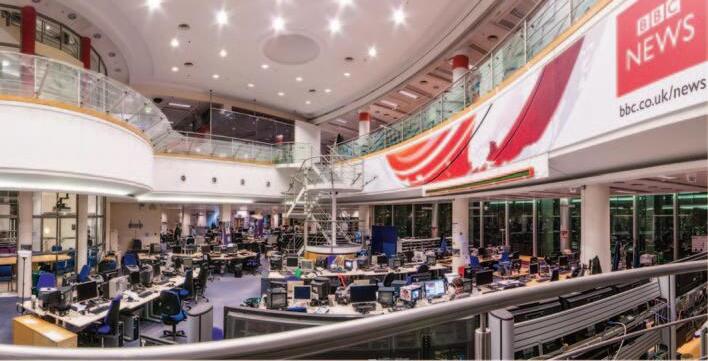

looked chaotic.As an editor with bothTV and radio credibility, I was pressured to lead the transition. I said no, I’m a journalist not a manager. So the head of news guaranteed me a return to programme-making after six months of sorting it out.
It was a trap.With all the teams happily settled in, I was approached to take on big editorial jobs. Each offer was vetoed by the head of news. I was frozen out. Months of miserable frustration ended with taking early retirement. It felt like a bereavement.
The week he left the BBC Tim, my Newsnight boss, had sat me down to warn me: “Your problem, Jon, is that you love the BBC too much, love it like it’s a human being. It’s a bureaucracy. All bureaucracies have cold hearts. They will never return your love.”
Lesson 7: I’m afraid my old boss was right
But it couldn’t stop me loving the BBC. I’d enjoyed an inspiring education in the company of extraordinary, warm-hearted people. Thank you, BBC, for letting me be a journalist. n
Isuppose there are a great many far more important and successful people than me in this world who could produce a schoolteacher to testify that he never believed they would amount to much. In my case I think there would be quite a number. But even at junior school I was beginning to discover that I could make people laugh, and I liked it. I was already learning to hide behind humour, to use it as a blanket which I could wrap right around my shyness.
Anyway, in spite of that I managed to pass my eleven-plus. I was lucky enough, too, to get a reasonably high standard of pass, which allowed me to go to King James’s Grammar School.
I was quite a bright boy at School, but I was lazy. Bone idle in fact. I remember one occasion when I was caught cheating with my French homework. It was not something I was in the habit of doing but somehow or other I had not done my homework by the time it should have been in, and it seemed like a good idea at the time to take somebody else’s book from outside the staff room and do some quick copying.With appalling timing I was just putting the other boy’s book back in the pile when the French master came out of the staff room on his way to assembly.
I had no chance. He
said not a word, let me sweat until next French class, gave back my book in which was written 1/10 (come to think of it, I don’t know why he gave me 1), and dispatched me to the Head.
We were getting to be quite good friends, the Head and I. He was a great headmaster, as it happens. He always wore a gown – not the mortar, but always the gown. He appeared to be very bleak, very stern, but actually had a smashing sense of humour.
He knew the story, of course, but made me tell him it and then asked how many marks out of ten I had been given.When I told him he just said he was going to give me three strokes of the cane. So I held out my hand and had nearly made it out of hisoffice when he called out: “Kaye!”
I turned around, desperate to leave. “Next time, copy off somebody who can do it, all right?”
I left school with just one ‘O’ level GCE – and that was French. So appropriate it barely seems believable, does it? Perhaps I was preparing for René even then. I certainly gave few signs of preparing for anything else worth mentioning. I could have done better.
GORDON KAYE was always known professionally as ‘Gorden’ thanks to a spelling error when he joined the acting union Equity.Although he appeared in many productions including Coronation Street, his enduring success was as René Artois in BBC Television’s popular comedy sitcom ’Allo ’Allo! The show went on to become a record-breaking stage show in London’s West End.
I think one of the reasons why I may not have tried as hard as I should have done at School was that about half way through my grammar school days I realised that

my parents could not afford to send me to university even if I were clever enough to go there. In Huddersfield there was a choice of three industries - textiles, chemicals or engineering. So I went into the sales office of a textiles mill: John Crowther’s, at Milnsbridge. I had lots of spare time and I had a good job earning £4 7s 6d a week. I also supplemented my income with a Saturday job in a local tailors, Montague Burton.

One day, I was talking to the Crowther’s dye house supervisor, saying I had all this spare time, and he said: “Have you tried hospital broadcasting?” Now that immediately appealed to me as I had al ways been a great fan of films and radio and that little upstart television.
Strangely, perhaps, I was never interested in appearing on stage at school, never one for the drama groups or any of that.That sort of thing wasn’t me at all.I was so incredibly nervous of standing up in public that I only ever did one school play, and it still makes me squirm with embarrassment when I think about it. It was Shakespeare’s Henry IV. I was Scroop, Earl of Masham, and I had to wear some particularly baggy tights. The whole thing was garbage, absolute garbage. And it was many years later before I actually gained the courage to venture out onto a stage again.
But off stage I was learning all the time to be a performer. I had been christened Gordon, spelt in the usual way, and I never in-
tended to change that O to an E at the end of my name.That was a total accident which happened at the very beginning of my professional career. My life was beginning to revolve more and more around the Bradford Amateur Theatre Group.The playwright Alan Ayckbourn was of considerable assistance during those early days. I had been in a BBC radio play directed by Alan, and I had made my TV début playing a railway guard in a play produced by the BBC in Manchester. I was, after all, a local boy. But what I was not, was a member of Equity. My name had already appeared in the Radio Times on a couple of occasions, and a number of people including Alan Ayckbourn had been pressing me to turn professional. So, unless I wanted to get myself blacklisted for all time, it was vital that I joined that hallowed actors’ union.
I wrote to Equity and enclosed what I thought was my registration fee.They wrote back and said they needed another £1 10sand the envelope was addressed to Gorden Kaye. I took this to be an omen (or ‘omon’ I say when telling this tale). I decided to keep my name as Gorden.
I had been a professional actor for only a year when I landed the part of Elsie Tanner’s nephew in Coronation Street.The show was seen by 500 million people worldwide, and I remember sitting in the bath in my little terraced house thinking:‘Here’s me, and I’m going to be in that. And I am going to be nervous as hell!” I could not believe my good for-
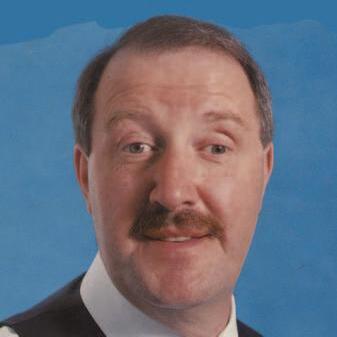
tune. My new job meant almost nine times the £20 a week salary I was picking up in rep. After all Coronation Street was, and for that matter still is, the country’s top-rated TV programme.
It was in 1981 that a big brown envelope dropped through the letter box. But it never reached the wall-to-wall special-offer carpet: I was sitting anxiously behind the door waiting to catch it.The BBC had told me to expect a very funny script for a new TV comedy series. I pounced upon it eagerly and ripped it open.

The first thing that fell out at my feet was a letter from the writer, David Croft, asking me to read the enclosed with a view to playing the part of ‘René Artois’ in a thing called ‘Allo ‘Allo!
I read it as Renée, the girl’s name. I was
absolutely horrified. I thought, oh my God it’s about the backstage goings-on of a drag artist. No, not even for David can I come up with that!
I had already worked for David Croft and admired him tremendously as the creator of quite brilliant sitcoms like Dad’s Army, It Ain’t Half Hot Mum, AreYou Being Served? and Hi-DeHi!. But my first reaction was that this time he was about to make an extremely embarrassing mistake. So it was with grave misgivings that I made myself a cup of tea, lit the inevitable cigarette, sat down in my favourite armchair, put my feet up, and began to study the script for the pilot episode of the BBC TV show which was to transform my life.
I quickly realised that thankfully I had got entirely the wrong idea. There was this hilarious script about the most unlikely of subjects, the Nazi occupation of France.
The night we recorded the pilot we all knew we were starting a great adventure and the atmosphere was quite electric. I have rarely been so excited. We did the show on a Saturday night in 1982 in Studio 8 at the BBC TV Centre, and on the Monday morning heard through the grapevine that there was a buzz going around that they had found a new sitcom that was going to rule the world.The extraordinary thing was that because of David Croft’s many other commitments it was over a year before we made another ’Allo ’Allo! He was a very busy man, still doing Hi-DeHi! and It Ain’t Half Hot Mum, and 1983 was just an empty year for us. So life carried on much as before.
’Allo ’Allo! was written by David Croft and Jeremy Lloyd and was broadcast on BBC TV from 1984 to 1992 and is still regularly repeated today. Cafe owner René Artois (Gorden Kaye) is shown here with his longsuffering wife Edith (Carmen Silvera).
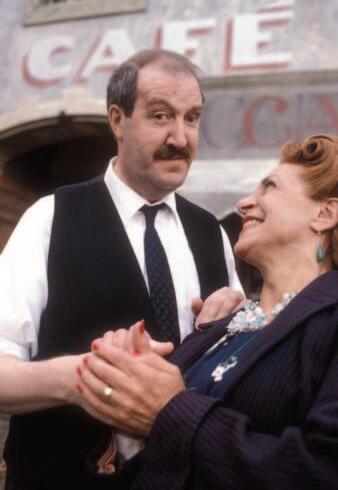
BBC Television

Centre Studio 8: the home of ’Allo ’Allo! throughout its long run. It was one of the most popular studios for light entertainment shows that included Morecambe and Wise, The Two Ronnies, Blackadder, Blankety Blank and countless others.

I was still Gorden Kaye the character actor from Huddersfield, almost always in work, doing quite nicely thank you, but largely unrecognized. That was not to last. René lurked just around the corner. He was to take me with him into a whole new world that a working-class Yorkshire lad could not have dreamed of. Now I have to get used to being recognized everywhere I go, and on the days when I would much rather be anonymous there is little I can do about it. Disguises do not work with me. René’s face is my face. Even the moustache is my own.
The ’Allo ’Allo! team, actors and crew, have been together a long time now. There have been few changes of cast since the 1982 pilot programme, and most of the crew have worked on the show since the beginning. It has been sold to more than 30 countries including France, and pulls in 16 million viewers here at home.
A return visit to King James’s School Happily, in 1988 I was invited back to the King James’s School Speech Day - I was
actually quite proud to be there. And I had to follow the Deputy Chief Constable of Yorkshire, who turned out to be very good and very funny, so maybe the standard has improved since my day. I simply apologized for René being unable to be there because he was working on a new series at Elstree, but said that he had sent a letter which I would read. Remembering my own boring speech days listening to dreary school governors rabbiting on, I gave them two pages of René on the horrors of speech days, and it seemed to cause some amusement.
Mind you, I think the School got its own back on me too. They gave me a nice picture in a frame - it turned out to be that ‘O’ level GCE certificate which I had never even bothered to pick up at the time.
Perhaps I should ask the BBC if we could display it on the walls of the Café René.n l Extracted with permission from René and Me by Gorden Kaye with Hilary Bonner (Sidgwick & Jackson 1989).
Gorden Kaye died in January, 2017. An interview recorded in 2007 can be heard on the OAS website at www.oas.org.uk/audio2.php
ON 11th November 1963 I became a member of the British Broadcasting Corporation. I was required to present myself to the Engineerin-Charge of the Television Outside Broadcast Unit in London on a starting salary of £885 per annum.

niently close, in Almondbury Bank.
My schooldays were fairly unexceptionable – I got roped in for most school plays, usually in minor roles though I did rise to the heights of Orsino in Twelfth Night one year. Sport was a complete nonstarter: I could never quite see the point of climbing up ropes or vaulting over horses.
But I did well educationally and was soon top of the class by a comfortable margin, so much so that the School decided for reasons that still elude me today that I should skip a year and go straight from Form 3A to Form 5A. Presumably the thinking was that it would ‘stretch’ me more but with hindsight I think it was a mistake. I suddenly lost the companions with whom I had joined the School three years earlier and found myself amongst fifth-formers – some of whom seemed alarmingly clever – who doubtless wondered who this strange new lad was who had been dropped into their midst.
There was no doubt in my parents’ mind that I should go to Almondbury Grammar School, as it was then known, as my eldest brother Derek had also attended the School ten years earlier. We also lived conve -
I had enjoyed my preceding seven years at Almondbury Grammar School, which I had joined from Moldgreen County School on 3rd September 1952. I must have been quite bright in those days as I was one of only two pupils from Moldgreen to pass the 11-plus on the ‘First List’ which gave one a free choice of any local grammar school.(The other was a girl called Edna Mellor, whom I quite fancied. On one occasion, at the age of 10, she and I decided for some unaccountable reason to walk the 15 miles from Huddersfield to Leeds.The occasion was somewhat spoiled for me by gooseberry Gordon (sic) Kaye, who lived near Edna.In due course, he too became part of the 1952 AGS intake and our paths would cross again in our time at the BBC).
DOWLING worked at the BBC from 1965-1986. His career started as a television outside broadcast engineer but he soon moved into technical planning for 625-lines and colour, working out of offices opposite Broadcasting House in central London.
His later career was outside London, initially at Leeds and Bristol and finally as a member of the management team at Manchester Network Production Centre.
I left KJGS in 1959 to study Electronics and Electrical Engineering at the Royal Radar Establishment’s College of Electronics at Malvern –four happy years that incidentally introduced me to the Malvern Hills and a love of the music of Edward Elgar that I have retained ever since.
I had no idea at this stage what I wanted to do in career terms. Indeed, it was purely by chance that I noticed that the BBC were travelling around the country in search of new engineers, and interviews were due to take place at Huddersfield Town Hall. Knowing that the BBC had a big transmitter at Holme Moss, my future suddenly seemed clear: the BBC needed somone to take charge at Holme Moss and I was clearly the man they were looking for.
As it happened, I was a keen radio ‘ham’ in those days so the idea of taking charge at the Holme Moss transmitter was particularly appealing – a point I made at every opportunity during the Town Hall interview. But when I was offered the position of ‘Engineer, Grade C’ the appointment was not to Holme Moss but to the ‘Palace of Arts’ at Wembley, 200 miles away.
Of course, the BBC has always rightly held its engineering staff in high regard, rightly believing that to broadcast programmes ‘wirelessly’ can only be achieved

through some sort of engineering miracle. Until 1979 BBC Directors of Engineering were traditionally knighted in recognition of their vital services to broadcasting.
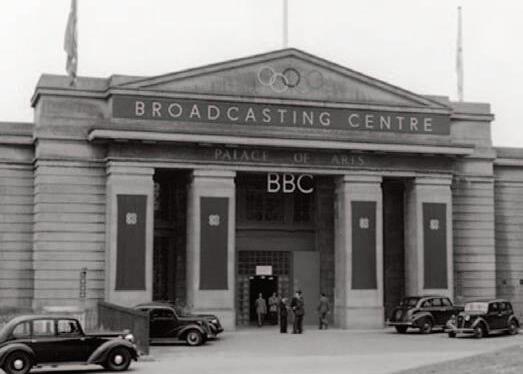
So it came as no surprise to me that my new elevated status as a BBC Engineer should require me to be housed in a palace though I have to confess that the reality was something of a disappointment. The ‘Palace of Arts’ was actually a somewhat shabby relic of the British Empire Exhibition of 1924; the BBC had taken over the building in 1948 as a base for its coverage of the Olympic Games and it subsequently remained the home of its mighty television outside broadcast fleet.
I well remember my first outside broadcast and the weighty responsibilities I had to bear. It was actually only a hundred yards away from the Palace of Arts: a soccer match at the old Wembley Stadium, built at the same time as the other exhibition buildings and one of the few to retain a useful role in later years. My duties were on the touchline, pointing what was known as a ‘gun microphone’ at the football to catch the sound of it being kicked around the pitch. I knew that my years of studying advanced electronics had not been wasted.
Or had they? A few subsequent outside broadcasts, including tediously lengthy coverage of the Henley Royal Regatta and a programme about an amazing new ‘service station’ at Farthing Corner on the M2 (yawn) were enough to persuade me that I really wanted to work on somewhat more technically demanding aspects of radio and television.
It’s worth remembering at this point how basic radio and television were back in the early 1960s. On the BBC we still used to listen to the Home Service, Light Programme or the Third Programme, broadcast on the medium wave, long wave or on FM if your pocket stretched that far. Television programmes, largely on 405 lines from Holme Moss, were still in black-and-white and included many hours of Test Card C during the day and such popular programmes as Tonight, Panorama and Come Dancing in the evening. One was expected to be in bed by midnight.
Television programmes still originated to a large degree from ancient BBC studios at Lime Grove, with news broadcasts

coming from the studios at Alexandra Palace in north London that had seen the launch of television 30 years earlier.
There were two main reason why the BBC were recruiting engineers in the 1960s: the introduction of BBC2 and 625-line televison in 1964 closely followed by colour television a few years later. To make this possible, the BBC had embarked on a massive programme of work to build new studios and outside broadcast units to meet the challenges ahead.
This appealed to me greatly and I was lucky enough to be promoted to a post in what was known as the ‘planning and installation department’ of the BBC engineering division based in Henry Wood House in central London, across the road from Broadcasting House. Here, the big bosses upstairs were debating and resolving all sorts of weighty issues, one of which was particularly fundamental: the choice of colour system to be used in the UK.The Americans had already led the way with a somewhat wayward NTSC system devised by its National Television Systems Committee. (The cynics reckoned that the initials stood for ‘Never Twice the Same Colour’). Inevitably, the French soon
Lime Grove studios at Shepherd’s Bush: originally built by the Gaumont Film Company in 1915 and acquired by the BBC in 1949.
Programmes produced there included The Grove Family, Dixon of Dock Green; Steptoe and Son; Doctor Who; Nationwide; Panorama and countless others.The studios were demolished in 1993.
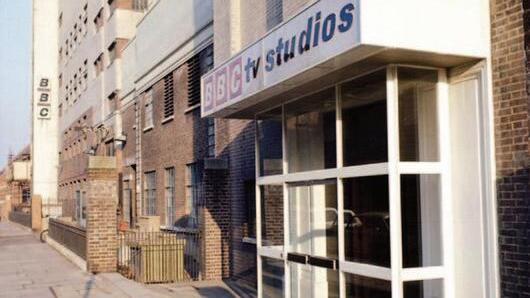
came up with their own SECAM (SEquential Couleur Avec Memoire) system, regarded by many as ‘Something Essentially Contrary to AMerica’. Fortunately the Germans then came up with their PAL (Phase Alternation Line) system which was in due course adopted by the UK and implemented in many other parts of the world. It was a case of ‘Peace At Last’. As a young engineer, my work was of course on a somewhat more lowly plane. I became involved in the design and construction of the BBC’s first-ever ‘colour mobile control rooms’ (the vast pantechnicons that bring you soccer from the Etihad or snooker from the Crucible). Another pioneering project was the design and equipping of the BBC’s first purposed computer centre at Sulgrave House, housing two enormous ‘main-frame’ ICL computers long before anyone envisaged that every office would have its own desk-top PC.
Lots of other interesting work was going on elsewhere in Henry Wood House. In the next office, a colleague by the name of George Hersee was busy designing a
new colour test card, initially based on the monochrome ‘Test Card C’ and its successors. He quickly came to the conclusion that a colour test card required human flesh tones and lost no time in offering a photograph of his daughter Carole, making her for many years one of the most recognisable young faces on British television.
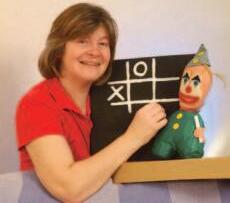

I worked on various projects at the BBC’s new Televison Centre. Work had started on this iconic circular building in the late 1950s and by 1964 five large studios and a small presentation studio were in operation, all in monochrome and on 405 lines.The massive engineering task was to build four more large general-purpose colour studios, two news colour studios to replace the old studios still in use at Alexandra Palace, and to convert the recently completed existing studios to make them colour-capable.
My particular involvement was in the complex lighting systems required for colour television. A major innovation was

that we commissioned a prominent UK company to design and build a first-ever computer-controlled lighting control system that was subsequently installed in the new Studio 8.
It was a magical place for a young engineer. For a start, each of the large studios had a large observation room overlooking the studio floor so it was great fun to look down on familiar programmes like Z-cars and chortle at the sight of Fancy Smith pretending to drive his Ford Zephyr police car around Studio 3. Occasionally, we’d get tickets for shows – I recall the unexpected pleasure of being served with mulled wine at a recording of ThatWas theWeek that Was on one occasion. At the end of the
evening (and often at lunch-time if I’m honest) another attraction was the BBC Club on the fourth floor where you could mix with the stars over a pint of beer.
Sadly, my work at Television Centre eventually came to an end and I left London to work at the BBC studios in Leeds, Bristol and latterly Manchester.
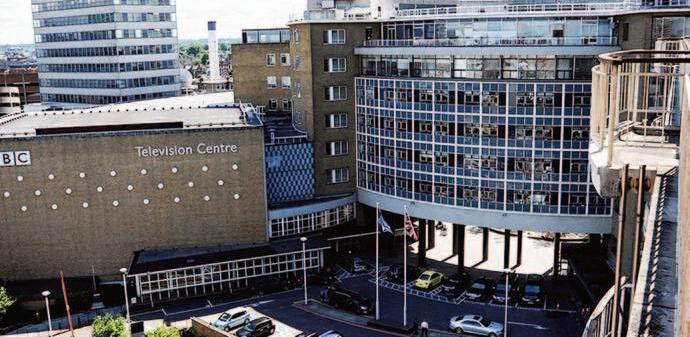

These too were challenges I relished, though nothing can really compare with working at Television Centre at such an exciting period.
Television Centre today
Regrettably, it no longer exists, at least in the form in which we originally designed it. The reasons were partly technical and partly political. By the 1980s and
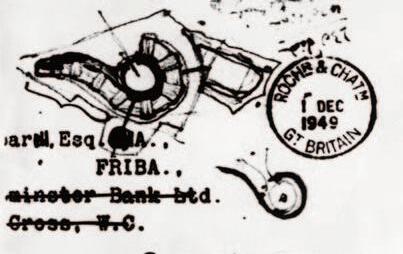
BBC Television Centre at Wood Lane, White City was the headquarters of BBC Television from 1960 to 2013.The architect, Graham Dawbarn famously drew a question mark on an envelope while thinking about the design of the building, and realised that it would be an ideal shape for the site.
It eventually comprised some 15 studios and, from 1997, a controversial bi-media News Centre.
1990s, the concept of producing drama productions in studios was going out of favour: increasingly, producers preferred to make their productions on location using lightweight colour cameras. The political pressure was to make more radio and television programmes outside London.

In 2013, the BBC committed corporate vandalism: the Television Centre site was sold to property developers for £200 million and most of the studios, on which so much money had been spent over the years, were demolished. Today, only Studios 1, 2 and 3 remain. Studio 1 (the largest by far) remains the home of big shows like Strictly Come Dancing; Studio 2 is used for ITV programmes like Peston and Lorraine; and Studio 3 currently broadcasts
ITV programmes Good Morning Britain and This Morning. Most of the central ring of the building, which had received Grade II listed status in 2009, has been converted into ‘bespoke apartments and penthouses’. Prices: from £2.75 million – a snip!
Come in, Z Victor 2: the studio reality was the remains of a decrepit Ford Zephyr in the corner of the studio. Moving pictures were projected on to the screen on the right to give the impression of passing scenery.
Finally what do I think, technically, of television today? Have standards deteriorated since I left the BBC? Of course, it would be flattering if this were the case but sadly the answer has to be “no”. Whenever I watch television today I am struck by how good it is – at least in technical terms. Thanks to modern digital cameras and transmission systems the picture quality in people’s homes in far higher than we could even achieve in the studio in my days. It used to take teams of engineers – and hours of time – to set up the gear and make it work. Today, you just switch it on and use it.
So I can understand why we no longer see my friend George Hersee’s colour Test Card these days. I’m not alone in regretting its demise: there even exists a ‘Test Card Circle’ of engineering enthusiasts who hold a Convention each year and spend a weekend enjoying an endless sequence of test cards and music.
So, as BBC funding gets ever tighter, here’s an idea for the future: why not bring back the Test Card? A few hours each day, like we used to have when I first joined the BBC – that would be lovely. n
In the last Farnley Lines I wrote that Peter Sanderson, one of the 1961 intake, mentioned at their dinner reunion that he remembered the registration number of my first car. Peter’s father owned the garage at Waterloo where our car was serviced. My son, Alan believed this was called The Reliance. Peter confirmed this to be correct and indeed we had a lively email exchange on various topics.
The registration number was 7768 YG. The YG always reminds me of Yves Gasnier, that very popular French assistant with whom our family enjoyed nearly fifty years of close friendship. His and his wife’s somewhat early deaths still cause us much sadness.YG was issued by The West Riding of Yorkshire. Much lamented by many are the disappearance of The Ridings and the times when each town of any size had its own registration number. Huddersfield have two: VH and CX?
Another soccer season draws to a close When I began my last Farnley Lines there was the distinct possibility of Huddersfield Town and Leeds United exchanging positions ie between The Premiership and The Championship. However, Town’s trip to Wembley was a great occasion but ultimately unsuccessful. Also we did not have to put Alan on suicide watch as Leeds United escaped relegation by winning at Brentford on the final day. At least Lincoln City are not
DAVE BUSH
involved so no stretched nerves in Porthcawl. As an aside I calculate I have now been supporting The Imps for seventy-five years. Am I due some kind of an award?
However, there are so many other teams which I follow. And there’s the distinction. Margaret has asked on more than one occasion how I can support so many teams and I patiently explain the difference between supporting and following. I support only Lincoln, Barcelona and for family reasons Leeds. After all it’s his and his mother’s birthplace. I ‘follow’ so many others as they are the favourites of friends and ex teaching colleagues. Arsenal (Bob Field), Man United (your editor), Chelsea (Fanny Walshaw), Spurs, (our postman for 20 years), Bristol Rovers (Patrick O’Brien). Looking down the league tables I could add many many more.
And then there’s Oldham Athletic, recently relegated from the Football League and so loyally supported over many decades by former KJS head teacher Robert Lamb. When their fate was finally sealed a pitch invasion ensued. My mind raced. I pictured headlines in the Huddersfield Examiner: Ex King James’s Headteacher arrested for leading pitch incursion at Boundary Park’. I had sent Robert an email of condolence and was relieved to receive a reply to say he had picked it up on landing from a holiday in Turkey. Enjoy your trips to Boreham Wood and Bromley next season, Robert.
How much I appreciate keeping in touch with OA’s via our Society, surely unrivalled by any other state school in the UK. An example occurred earlier this year when a succession of severe storms struck. As is so frequently the case, Porthcawl was featured widely both in the national press and on the main news channels as waves crashed over the breakwater and lighthouse. I sometimes wonder if archived material is used. Old Almondburians contacted me in surprising and gratifying numbers for assurance that I had not been swept off the promenade. The seas were indeed spectacular. I may have mentioned before that The Bristol Channel has the second highest tidal range, 49 feet, in the world beaten only by The Bay of Fundy in Canada with 53.5 feet. Given a south westerly gale, a spring tide and water consequently ‘funnelling’ up the channel and dramatic scenes are guaranteed. If I am feeling lazy I can view them by using my telescope from our upstairs study.
Storm at sea: waves crashing over the Porthcawl lighthouse regularly feature in the national press
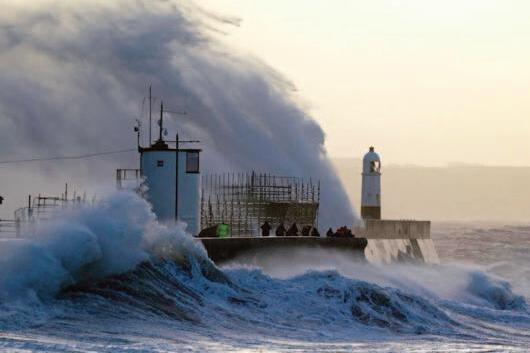
Enforced by corvid – sorry, covid – restrictions, the aforementioned telescope has not been on any exotic birding trips. I have not given up hope of making at least one more. This has meant more time watching and recording birds in our garden. Rules are strict. No flyovers are listed. Birds must be perched in the garden or in tree branches overhanging it. Each year swallows perch on our telephone wire but frustratingly not quite over our drive. Most species, now nearly fifty, are welcome but not that heron who took many of our goldfish. Now its dining room is covered; a case of netting the pond after the heron has bolted ...our prize pisces. Also aves non grati are those avian hoovers, starlings. Ideas for a deterrent on a postcard or by email, please.
More news on the home front? I do hope, dear reader, that you will find something of interest here. Changes have been occurring regularly on the family front. Son, Alan has retired – I must be getting old – and daughter, Catherine and husband, Javier have left Greenwich and are now splitting their time between
Barcelona and Cardiff. Grandson, Jordi is earning more than a crust as a teacher in a private 6th form college in Barcelona. Granddaughter, Anna is a features writer at the i newspaper. This means my no longer taking the Telegraph after 40 years. Switching to the i cryptic crossword has proved a real challenge. This plus a daily Mensa problem plus Wordle keep the grey matter in good order, or so I delude myself. Badminton every Thursday helps the belief that physically I am not yet completely over the hill. I cannot retire yet while each week I give a lift to my very Welsh friend, David Vivian Thomas still playing at 91 years and 4 months. Any OAs remember Stan Gilling, who played Badminton with us into his 80s?
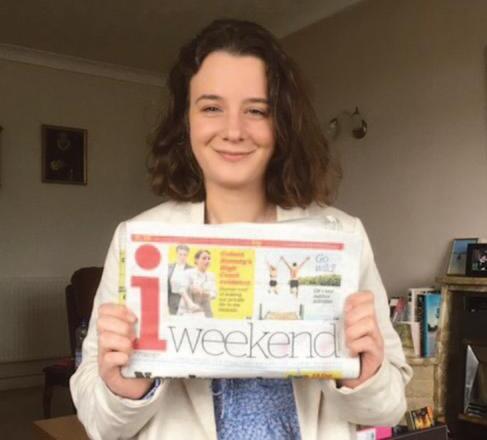
Yet despite all the above serious decluttering in the Bush household is underway. One box on its way to the tip contains my sporting trophies, What recollections are vigorously stirred. ‘Single Wicket Winner’.I remember defeating Richard Taylor in the final. This resulted in my ill advised appearance for Almondbury
1st XI captained by Eddie Leadbeater, Yorkshire and England, in a Sykes Cup
Match. My contribution does not merit a mention. ‘Barr Cup Winners 7980’,’Yorkshire Old Boys Div 2 Winners 77-78’ and so many memories. Such happy memories and so sad that so many leagues and clubs no longer exist.
As ever I conclude on a positive note. My book continues to sell albeit spasmodically. Not many copies left so if you want a first edition signed copy please get your request in quickly. Carpe diem which does not mean ‘fish of the day’ as once suggested on a radio programme...
Exciting times as the KJS extensions are finally opened which should mean Little Tree’s seating project can go ahead and there’s a visit in June from a prominent Old Almondburian. So much I can look forward to, or should that be to which I can look forward? What a pedant! n
Thanks to Newnham College, Cambridge and the generosity of KJS parents, it’s now hoped to complete the OAS ‘Big Tree’ seating project over the summer. ROGER DOWLING reports.
WE have reported in previous issues on OAS plans to provide new seating in Big Tree yard to replace that which existed until the tree was unexpectedly felled in 1997.
The intention was to install new seating around an existing established yew tree which stood not far from the location of the original Big Tree. However, this has been delayed in recent months because the tree is located very close to the temporary portable classrooms erected during the construction of the new teaching block at
the rear of the School. Now, frustratingly, there are plans to retain the portable classrooms for a further period, putting back the seating project to an indeterminate time in 2023.
But all this is now set to change – and we must thank Cambridge University’s Newnham College and the generosity of KJS parents Ros and Jake.
Newnham is one of the 31 colleges of the University. It has around 400 undergraduates, 300 postgraduate students and 70 academic staff. The College was established in 1871 as a women’s college at a time when women were not

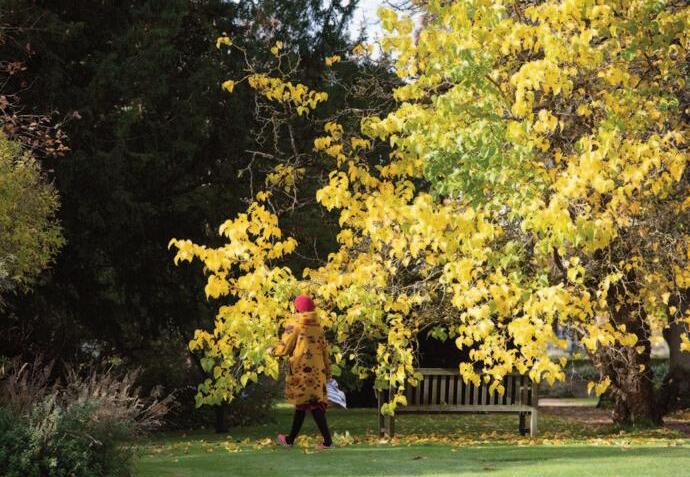
‘Society grows great when old men plant trees whose shade they know they shall never sit under.’
GREEK PROVERB
even allowed to attend the University. Its co-founders included Dame Millicent Garrett Fawcett, the famous campaigner for women’s suffrage. It is the oldest College run by women, for women.The College, about 10 minutes’ walk from the historic centre of Cambridge, has a mixture of beautiful historic and contemporary buildings, set in stunning gardens.
To celebrate its 150th Anniversary, the College launched a ‘Global Tree Planting Project’ which aimed to plant at least 150 trees around the world.The inaugural tree was planted at the College in March 2021, and the 150th will be planted in the College gardens as part of the university celebrations during its weekend Festival of Arts, Science and Ideas in July 2022.
But the project continues. Since it was launched trees have been planted in private gardens and community orchards, at re-wilding projects and primary and secondary schools and the College is now seeking further connections with schools around the UK.
The link between Newnham College and King James’s School is former KJS Head Girl Evelyn Surman, who attended King James's School from 201419 and was Head Girl in Year 11. From KJS Evelyn went on to Greenhead College where she studied English Literature, Biology and Psychology at ‘A’ Lev-
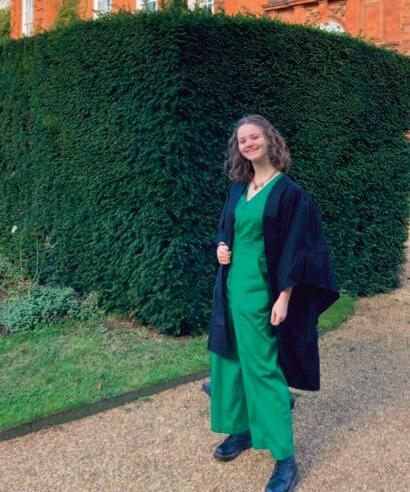
el before winning a place at Newnham College to study Human Social and Political Science. She has just completed her first year and is already throwing herself into college and university life, representing Cambridge at gymnastics, trampolining and climbing in competitions across the country. She has also been appointed on to the JCR at Newnham as the Widening Participation Officer with the brief to mentor applicants from comprehensive schools and underrepresented groups. Evelyn plans to return to KJS soon to talk to Year 10 students about studying at Cambridge with a view to inspiring others to do the same.
Her parents have now generously agreed to sponsor a new tree – planned to be a yew – at KJS to support the Newnham College Global Tree Planting
Project, and this new tree - hopefully to be planted over the coming monthswill be the centre-piece of the new Big Tree seating project.
“Evelyn feels privileged to attend Newnham College,” says Ros Farrell who has been a Governor of King James’s School since 2019. “She follows in the footsteps of alumnae including actress Emma Thompson, writer Virginia Woolf and broadcaster Clare Balding. And her room is in the same building as the of -
fice of historian and broadcaster Mary Beard, another prominent former Newnham student!”
OAS chairman Walter Raleigh is delighted by the new plan. “The original plan would have meant deferring the Big Tree seating plan for up to a year due to circumstances outside our control,” he said. “Now there is every prospect of completing it over the summer months, and certainly by the date of the OAS Annual Dinner in Novembe r.”
Contributions to the Big Tree project are still very welcome
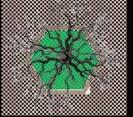
OUR thanks to OAS members who have already contributed almost £1,000 to the special fund to restore seating around the proposed tree in Big Tree Yard. Donations can still be made on our website at www.oas.org.uk/donate.php
You can also ontribute by BACS: our account number (‘The Old Almondburians’ Society’) is 00814458, sort code 53-61-07. Please give your full name and mark your donation ‘Big Tree’.
Alternatively, if donating by cheque please complete the form below and enclose it with your contribution. n
To: Andrew Haigh, R D Haigh & Co, Oakhill Road, Brighouse, West Yorkshire HD6
Name Address

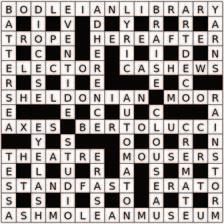 Hérisson
Hérisson
Entries to the Editor (address/email: back cover) by 30th September 2022. Prize: 12 months’ free OAS membership
8. Short, sound car. (4)
9. A curio Dean collected for South American. (10)
10. Need line arranged around five to get aroused. (9)
11. See instructions above. (5)
13. Unstable, Morecambe, perhaps, captures deserter. (7)
14. Smoking remains in here. (7)
16. Present that woman’s remarkable finale. (4)
18. Near a ruined amphitheatre. (5)
19. Sulphate mix up he left for compound. (4)
20. Firmly drunk on empty, luckily. (7)
22. Grass free sea port, (7)
25. Support church strength. (5)
26. Once more, not a part of Wimbledon battle. (9)
28. I front up to corrupt editions no longer available. (3,2,5)
29. Tickle informant losing partners at table. (4)
1. Carpet athlete. (6)
2. Make slight improvements to bird Evita assembled. (8)
3. How to act contrary to established
Starting with yellow square 1 and working clockwise, the yellow squares spell out the name of a novel. The author’s name is 4 down and 11 across.
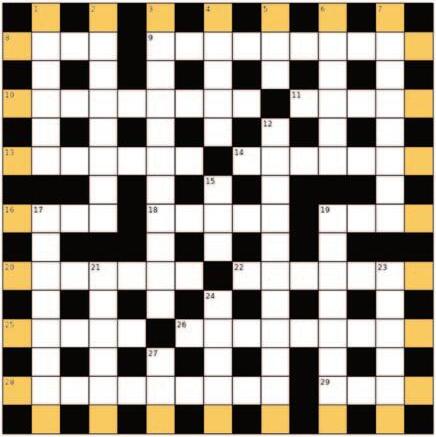
l The winner of Crossword by Hérisson (March 2022) was J M Sykes (1946-54)
practice – 16 convulsion with collaborator. (11)
4. See instructions above. (5)
5. Not even one decent decision at first. (3)
6. Not to be delayed, press Newport to be evacuated. (6)
7. God in descent from the heavens opening. (8)
12. Kill two donkeys in tea dispute. (11)
15. Important opener. (3)
17. Two records about one, under exposed initially and in conclusion. (8)
19. Shapes up Norwegian, Icelandic and Czech leaders for language descriptor. (8)
21. Browbeat Trojan hero. (6)
23. Re 29 revised 3x. (6)
24. A win repeated. (5)
27. Choose zero training. (3)

Things often look different when viewed from afar.We invite our man in the US to give us his personal perspective on some of the issues and questions of the day
QEverything has become ‘woke’ in the UK these days. Is it another import from the US that we would be happier without?
Charlie’s view
Awake? Awakened? Awoke? Woke? What? I’m not sure when I first heard the word ‘woke’ used as an adjective. Had I been living in a cave? I suppose it crept up on me, along with other hip and groovy terms like Critical Race Theory, non-binaryness, cisgender, LGBTQIA+, heteropatriarchy, toxic masculinity, cancel culture, replacement theory, white privilege, et al. Recalling my upbringing, I couldn’t say that ‘white privilege’ accurately described my life experience, but then again I didn’t face racism and discrimination every day because of the colour of my skin.
Well, what exactly is ‘wokeness’? At first, I’d assumed it was interchangeable with ‘PC’. Not PC as in Dixon of Dock Green (the vintage TV police drama from the Bakelite age), nor the desktop personal quantum supercomputer I’m currently plonked in front of, but rather our cringeworthy friend ‘Political Correctness’, i.e. the avoidance of unfiltered lan-
guage or behaviours that may cause offence. Alternatively, it can be interpreted as the pressure to conform to someone else’s agenda and stifle ‘lively’ discussion. As Westerners we’re considered fortunate to enjoy the freedom to speak our minds, yet as members of polite society it’s incumbent upon us to consider how our words and actions can sometimes be hurtful to others. Ever helpful, Microsoft have introduced a feature to Office 365 software that can alert writers to potentially inflammatory phrases by automatically undermining... sorry, underlining them in purple and suggesting kinder, gentler alternatives. Good luck with that.
As I understand it, wokeism seeks to alert us to the overlooked inequities of our past and present; to review societal progress with a critical modern eye; foster racial and gender diversity; promote fairness and social justice; call out class privilege, stamp out sexual harassment in the workplace; hold accountable those who have escaped their deserved comeuppance; require gender-authenticity in the acting profession; imprison Batman for being a vigilante. And perhaps temper the questionable content of OAS opinion pieces such as... this one.
“I am filled with foreboding; like the Roman, I seem to see ‘the River Tiber foaming with much blood’”. MP Enoch Powell’s immigration speech in 1968 remains today a subject of controversy and condemnation.
Can a bloke grow to be woke? Since my callow youth I’d like to think I’ve evolved into a more thoughtful, somewhat more charitable, animal rights-advocating, quadruple-vaccinated, salad-chomping chap. I was not always so perfect. Almost five decades ago I bore witness to the transfiguration of King James’s from Grammar School to Short-Lived Hybrid Co-ed Sixth Form College Thing. Our bastion of learning’s days as an all-male preserve were winding down and in my capacity as a contributing editor of The Almondburian I innocently suggested that the 1975 summer issue should, in celebration of those newly enlightened times, feature a spoof ladies’ journal wittily titled Women’s Monthly. Ho hum. The publication evidently evaded staffroom redaction before it went to press, but it’s highly unlikely such adolescent japes would pass muster today.
Woke or not, it’s impossible to be impartial and not judge fascism, Nazism, racism, and even Jeremy Clarksonism as inherently evil and deleterious to man/womankind. In the early 1970s, Conservative politician Enoch Powell’s anti-immigration ‘Rivers of Blood’ speech was still fresh in the public’s mind. Despite bravely enduring the wind, rain, and snow of Yorkshire summers, coping with racial climate change didn’t come easily for every tyke raised in the West Riding.
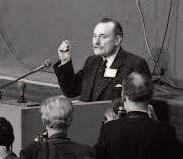
A minor seismic disturbance was felt down St. Helen’s Gate when the Yousaf
brothers, Taher and Shahed (aka Taff and Shaf), were inducted into our traditionally vanilla institution*. Taff was a fascinating anachronism, a jiving ’50s rock and roll fanatic who roguishly bent school uniform rules by sporting a long Ted-style drape jacket, while his young brother Shaf was a science nerd and fellow member of the Huddersfield Astronomical and Philosophical Society. More than once I witnessed Yousaf the Elder provoked to physically defend himself against the slings and arrows of several ‘lads’ who elected to make newcomers of Pakistani descent feel less than welcome. Thankfully, our teachers swiftly cracked down and deemed that kind of behaviour unacceptable on school grounds.
Meanwhile, in the US we’ve already seen a backlash against wokeness. It’s become yet another tool weaponised by patriotic, red-blooded, heartland Republicans against those despicable Democratic, fetus-killing, cop-hating elitists who snootily look down on rural Amer-
*Taher and Shahed Yousaf attended King James’s from 1970-77. Both enjoyed successful careers in chemistry and biochemistry.
ica. The last time the nation was this polarised was during its not-so-Civil War when friends and families were similarly divided and torn apart by disparate, deeply held beliefs and allegiances. The implication these days is that if you’re not in favour of something you must be agin it. Intolerance runs rampant, espoused and promoted by paranoid gun-totin’ lunatics through social media and cynically employed at political rallies to sway voters. Either way, we’re all being manipulated and our only defence is to be aware and vigilant.
As many professional comedians and social commentators can attest, being too sensitive threatens to censor the humour out of our lives. Incautious comments by some jokesters have recently been getting them into hot water. Ricky Gervais, while hosting America’s Golden Globe Awards, voiced his woke-cynicism by skewering the hypocrisy of many self-proclaimed Hollywood progressives, noting how quickly they turned on disgraced movie mogul Harvey Weinstein after years of benefitting from his patronage. (Surely, Weinstein’s proclivities were well known within that tight-knit community, as was the case with Jimmy Savile in the UK?) It’s doubtful whether many ‘classic’ Monty Python and Goon Show sketches would’ve made it past BBC censors had they been written today. What might we be permitted to laugh at next week, then, sans guilt? Will we dare chuckle at irony? Will pratfalls still be risible? As payback for disingenuously using
the Bible as a prop in claiming to support ‘Christian’ values, wouldn’t it be hilarious to see former President Trump trip over a large-print King James Edition and fall headfirst into a steaming pile of... no, let’s not go there.
On second thoughts, let’s. Speaking of Trump, in the days when I was wearily commuting from New Jersey to the Big Apple a friend would graciously lend me her uptown New York apartment to use when she was out of town. Her address? The 24th floor of Trump World Tower, opposite the United Nations Headquarters on First Avenue. Floor-to-ceiling Trump windows offered a sweeping Trump view of the NY skyline, and each day I was courteously greeted by a white-gloved Trump concierge who addressed me by name. However, whilst despising everything the race-baiting misogynist huckster stood for, I was also painfully aware I was being a complete hypocrite. Although I wasn’t paying Donald Trump a dime for this short-lived hedonistic experience I actually felt pangs of guilt... but not enough to decline my friend’s kind hospitality, of course. “Your woke cre-

dentials (such as they are) are henceforth revoked, Mr Starkey.” Oh my.
America’s current unease is fuelled by more than just encroaching wokeness. In their 1970 book of that name, Alvin Toffler and Adelaide Farrell defined the term Future Shock as ‘too much change in too short a period of time’, causing a destabilising loss of familiarity that old institutions once provided. In addition to the accelerating pace of technological change, other contributing factors to our angst include a perceived decline of moral values, loss of digital privacy, obeisance to megacorporations, an everwidening gap between rich and poor, the older generation’s fear of immigration and the shifting racial makeup of the country, fear of climate change, fear of China’s rise as an adversarial world power and incubator of deadly viruses, fear of Vladimir Putin’s next move, fear of North Korea, fear of errant asteroids, and disgust with autotuned pop music.
Conservatives, frustrated by America’s progressive movement over the last few decades, decree that the discussion of slavery, segregation, and discrimination is fine as long as it doesn’t make Straight White Males feel guilty for perpetuating bigotry and homophobia. In other words, the Right values the right to speak one’s mind regardless of consequences. And speaking of rights, across the US the legal right of women to control their own reproductive choices is once again under fire with Supreme Court justices moving to
overturn the landmark 1970 Roe v. Wade decision and potentially criminalise abortions even in cases of rape and incest. If only men could get pregnant...
It seems difficult for those on the Right to accept/understand/tolerate causes like Black Lives Matter, feminism, slavery reparations, Extinction Rebellion, and worst of all... wokeness. They feel Traditional American Values, whatever those might be, are under threat and are fighting hard to marginalise and extinguish these movements. As a consequence, nervous citizens have been purchasing weapons in record numbers, deceived by the National Rifle Association into believing their right to keep and bear arms against wussy Liberals is in jeopardy. Not to worry, if you don’t feel like strolling down to the local Walmart store to purchase a gun you can now 3D print your own at home. In unrelated news, mass shootings have recently been increasing and internet-radicalised, guntotin’ wackos – and police – have been a-killin’ Black Americans in greater numbers. At the time of writing, in the merry month of May, America is in a panic about running out of infant foods, but not bullets.
Not content with attempting to subvert/upend the democratic election process, some on the Far Right have been praising Vladimir Putin’s hard man stance for directing the Russian military to besiege neighbouring independent Ukraine, thereby crushing an existential threat to his concept of nationhood. Steve Bannon,
In the merry month of May, America was running short of infant foods, but not of bullets.
disgraced (but pardoned) chief executive of Donald Trump’s political campaign, praised Putin as ‘anti-woke’ for castigating ‘cancel culture’ and transgender acceptance in the Land of the Free. Yet Putin’s brutal action against Ukraine is ominously reminiscent of America’s flagrant disregard of UN protocol when it decided to wage a ‘war on terror’ against Iraq in 2003, and napalm entire villages during the Korean and Vietnam proxy wars. (Napalm is internationally labelled a ‘legal’ battlefield weapon yet its use is classified as a ‘war crime’ when targeting civilians, a confusing distinction no doubt keeping Dow Chemical Company executives awake at night.) Of course, war is always hell for everyone involved, for whatever reason and wherever it’s happening, but the US public appears more concerned about inflation and the rising price of food and gasoline than what’s happening overseas. Perhaps I’m being too harsh. There is a lot of moral outrage over here... most of it directed at Will Smith for slapping comedian Chris Rock at the Oscars ceremony. When did this new wokeness emerge,
Four people were found not guilty of criminal damage after toppling a statue of Bristol trader Edward Colston in June 2020.
then? It gained traction in response to widespread social unrest following the infamous 2020 killing of George Floyd by white police officers in Minneapolis, Minnesota. Monuments tied to racism and the historic exploitation of Black people were vandalised and deplinthed, with Christopher Columbuses becoming popular targets alongside Confederate heroes of the Civil War. (Southern states still rue the day that the North emerged victorious.) Lest we forget, the slave trade was vastly lucrative for Britain from the 1600s onwards until its abolition in 1808. It helped fund the growth of major cities such as London, Bristol, and Liverpool, but recent attacks against statuary honouring slavery profiteers like Bristol’s Edward Colston have shined a light on a conveniently overlooked part of England’s past. Is it a mistake to remove these effigies from public view? Personally, I believe they are historically relevant and ought to be preserved but amended with contextual information that fully documents their tainted origins. The unpleasant aftermath of colonialism has lingered beyond the dismantling of the British Empire. The Windrush scandal during Teresa May’s premiership highlighted the tribulations of thousands of Commonwealth citizens who legally immigrated to Britain between 1948 and 1971, and it’s an issue that continues to resonate today.

Great Britain didn’t go through a learning experience as dramatic and fundamental as America’s Civil Rights Movement. Several polls in the 1960s suggested many Britons held negative views regarding immigration but I don’t remember the topics of segregation and racism being taught in schools back then. For example, it’s doubtful children of my generation associated the hobby of collecting ‘golli wog’ labels from Robert son’s Marmalade jars with oppression. In retrospect it’s surprising that Robertson’s waited until 2001 to retire its iconic logo. It’s also painful to recollect that The Black and White Minstrel Show, a massively popular BBC musical variety programme featuring white per formers in blackface makeup, re mained a broadcast staple for a full twen ty years from 1958 to 1978. The Corporation responded to occasional accusations of insensitivity by insisting the show was merely "good-hearted family entertainment" and "not racially offensive". Just because systemic racism might be unconsciously embedded in our culture that doesn’t mean it’s defensible.
Some of our institutions have had difficulty changing with the times. Present day America continues to be embroiled in racial strife. Thirty years ago, four white Los Angeles police officers were caught on videotape savagely beating African American motorist Rodney King after a highspeed car chase. When their trial resulted in acquittal by an all-white jury, long-
standing tensions between the LAPD and the Black and Latino communities erupted into days of widespread rioting and arson the like of which hadn’t been witnessed since the city’s 1965 Watts riots. Rodney King himself pleaded to the country “Can we all get along?” You’d expect after thousands of years of civilisation we’d have learnt to be civil to each other and discussions about wokeness would be redundant, but you’d be sadly mistaken. Even now, ahead of the next election cycle, Republican politicians stung by President Joe Biden’s 2020 win are trying desperately to redraw electoral maps to the disadvantage of their Black citizenry, even if that means violating the Voting Rights Act.
The ‘original’ oppressed peoples of North America, its indigenous tribes, ignorantly branded by European colonists as injuns, savages and redskins, were largely eradicated through cultural genocide, victims of the great westward expansion. The tropes of scalp-hungry, heathen barbarians perpetuated by Hollywood and popular culture endured until the middle of the last century by which time the survivors were finally being recognised as Native Americans and First Nations. In addition to using their preferred tribal names they also once thought of themselves as Human Beings, existing in kinship with the land and all living things.Woke or not, surely that’s a goal we all should be striving for? And please, stop calling me Shirley.
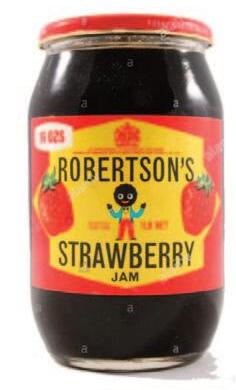
In conversation with RICHARD TEALE, David reflects on his time at King James’s, his career in banking and his move to rural Somerset after taking part in BBC Television’s ‘Escape to the Country’.
IN September 1968, King James’s Grammar School headmaster, Harry Taylor, called me into his study and announced that I was to be Head Boy. He went on ‘of course, we expect our head boys to go to Oxbridge’. I came out of his study wondering where Oxbridge was and what I had let myself in for! In the UCCA booklet, I found Oxford and Cambridge but where the hell was Oxbridge? My classmates found that very amusing and put me right.
I chose ‘Arts’ in Transitus and was turned on to Geography by Fred Hudson. In my third and final year of sixth form my Geography lessons were personal tutorials with Fred and I responded with a distinction in the ‘A’ level examination. I wanted to study Geography at university but was asked for an ‘A’ level in Geology, a subject that I could not study at KJGS. However, Fred knew the Head of Geology at Ramsden Technical College and he arranged for me to take night classes during a year after leaving school when I sought work in the textile industry. At School, we had been raising money for Freedom from Hunger, and I offered to wash the car of French teacher, Margaret Hebblethwaite, for 5/- [25p] a
time. She was impressed and offered my services to her neighbours in Beaumont Park and I soon had a weekend business. This also led to Margaret’s husband Gordon offering me work at his mill, Sykes & Hebblethwaite , for my year out. I worked in many departments and finished up in sales, but I did not let Gordon know that I was colour-blind. I was allowed time off for my studies and, after adding Geology ‘A’ level, grade C in one year from scratch, (not perfect,
“Oh, wow!”: Dave and Caroline Cunningham found their new dream home in Somerset with the help of Escape to the Country in 2018.
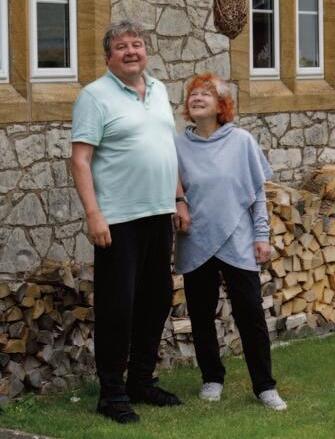
there were some faults!) I was accepted at Newcastle University, (not Oxbridge).
After university I was recruited by Barclays Bank and moved to Leeds. Most graduates start ed in London, but after my first year at University, I married Jennifer who had a good job in textiles in Huddersfield and we were expecting our first child. I later moved to London to gain experience and then accepted a manager’s job in Guildford. We settled down to family life in Surrey and, as our children (soon to be four) progressed through local schools, I was reluctant to move again.
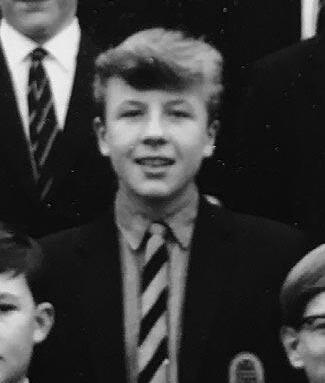
I enjoyed the many roles I had in the bank. After two years in branch management, I became area business advisor in Surrey and the Thames Valley, and then Head of Group Management Training at the college in the Ashdown Forest in Sussex. Then I became Head of UK Systems planning in Lombard Street, and I ended up running the Corporate Business centre in Brighton and Maidstone, retiring in 1999 on an unbelievable package.
In 2002 I separated from Jennifer. The children had all left home, so after a sixweek bachelor rampage in America, I settled down to live alone in the family house. I had set up my own very lucrative Strategic Planning Consultancy which funded my expensive divorce, but the single life was not to for me and af -
ter six months I met Caroline. We set up home together in Surrey but had hopes of moving on and downsizing. We married with a spectacular party in July 2006.
Time passed, though, and by 2018 we were still in the house in Surrey where I had lived for 38 years. We wanted to get out of the London shadow and identified a desirable search arc from Dorset, through Somerset and Gloucestershire to Herefordshire. To expedite things, we put the house up for sale and it sold within four weeks!
While the house was on the market we were watching Escape to the Country on BBC1 and a postscript said ‘if your house is on the market and you wish to escape to the country, please apply’. We thought ‘why not?’ Caroline (maybe emboldened by a glass of wine) called Fremantle, the production company and the first question was: ‘where are you looking?’ We settled on Somerset. They replied they were proposing to film a programme there in two weeks and would like to do a telephone interview with us to assess our suitability. Well, my dulcet Yorkshire tones settled it for them – “We’re thinking o’ flitting out o’ t’’ Smoke” - and they sent a film crew down to spend the day with us in and around our house from which we intended to escape. They asked us not to arrange any
of our own viewings in the Somerset area so as to avoid any of the properties they intended to show us. We also fixed our budget at £550,000.
We were asked to go to the five-star Ston Easton country house hotel between Wells and Bath where, on the Monday, we met the production team. Margherita Taylor was our presenter and we hit it off straight away. Our very wellspoken producer, Titus Ogilvy, introduced himself to us. He was from West London but didn’t rise to my taunt that he hadn’t spent much time in t’ mill. He started to brief us and said we would get our p’diems which eventually (thanks to Dave Bush) I translated through school Latin as being ‘per diem’ - daily expenses. Well, £20 a night each inevitably became liquid expenditure.
On Tuesday we were taken on the West Somerset Railway - they had earlier discovered my interest in trains. The next
day, was our first day of viewing and we were taken to Ashill near Ilminster. The first house was very nice but was set in a lot of land that we weren’t really looking for. It was a very hot day and the owners of the house had prepared an outdoor picnic lunch for us. I was somewhat surprised to meet them and worried that they had heard some of my earlier critical comments about their house!
We moved on from there to the next property, the Old School at Fivehead. Our first reaction was ‘Oh wow’ and this and our subsequent gushing praises necessitated much use of “Cut!” and retakes. The house size, potential and the fact that it did not need much work doing to it perfectly fitted our requirements. Even my large model railway layout could be accommodated in the extensive garage. We met the present owners of this house also and found out
BROADCAST in various formats on BBC1 and BBC2 since 2002, Escape to the Country has become one of the most popular daytime television programmes. Featured couples are taken on tours of several houses (including a ‘mystery house’ possibly offering unexpected challenges) before being asked to estimate the likely purchase price.The programme’s many popular presenters over the years have included Marguerita Taylor and Jules Hudson (right).
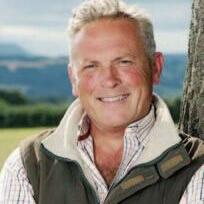
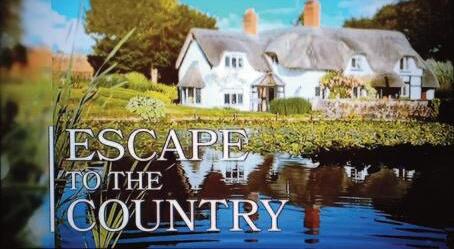
that they wanted to move out fairly quickly, so
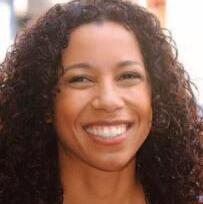
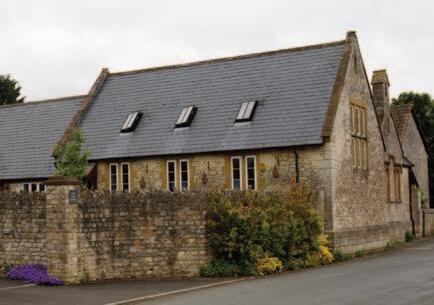
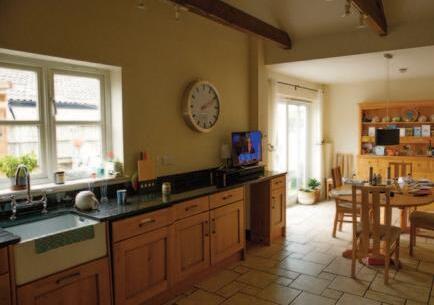
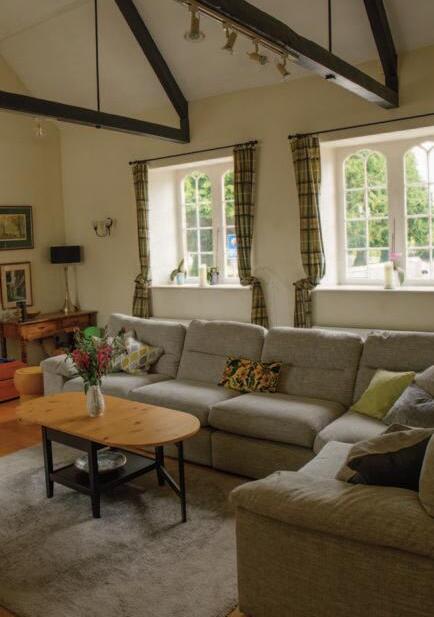

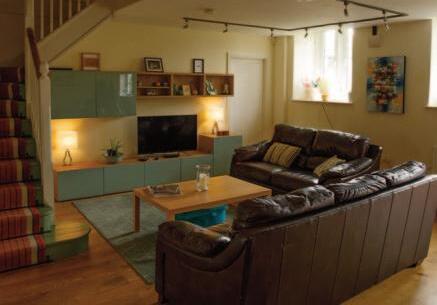
 1. View from Fivehead Main Street
2. Garages (train rooms!)
3. Kitchen and dining area
4. TV lounge where Terriers were beaten
5 & 6. Main lounge overlooking 13th century Church.
1. View from Fivehead Main Street
2. Garages (train rooms!)
3. Kitchen and dining area
4. TV lounge where Terriers were beaten
5 & 6. Main lounge overlooking 13th century Church.
things were falling into place.
That night we were invited out by the crew to a pizza restaurant in a converted chapel in the town of Bruton. They don’t invite all their ‘escapees’ out but we were privileged because we “made them laugh”!

On the Thursday we were taken to the ‘mystery house’ at Evercreech. It was half-Georgian, half-Victorian and a project half-finished, so was quickly discounted. We returned to the Ston Easton and sat out in the grounds to discuss our experience with Margherita. She asked “Why Somerset?” and I replied that “It had rolling hills, lovely villages and friendly people and in that respect was a close second to Yorkshire!” We quickly came to the conclusion that the Old School was for us.
The next day we returned to explore the village of Fivehead. We made an offer to the house owners which to my chagrin, they accepted. We then had an eightweek conveyancing period which meant putting all our furniture from our sold house into storage and living in our caravan in Somerset.
We went into what was to become our local pub and became celebrities when the landlord discovered we had been filming in the village. We were introduced to many of the regulars that have now become good friends, so much so that our house warming party, ten days after moving in, was attended by 50 people.
Fifteen months later we were again filmed for the sequel programme I Escaped to the Country. As our main achievement since moving had been social, we had a party for a dozen or so of our friends to the joy of presenter Jules Hudson and his crew who spent ages operating my train set.
And so to the house. It was built as the village school in 1873 and continued in use as such until 1966. Many of the older locals can remember being taught ‘sums’ in what is now our living room. It then became the village hall and served that purpose until 2006 when it was converted into a dwelling by the people we bought it from. We have a planted front garden and a back courtyard now largely covered by a gazebo. It is our perfect retirement property.
Having said that, getting old seems a high price to pay for achieving maturity. For me the secret of life is sincerity –once you’ve learnt to fake that, it’s a piece of cake!

Our Annual Quiz has come around very quickly this year as it’s only seven months since we last gathered in theWoolpack for the Covid postponed 2021 Quiz.
AFTER another keenly fought contest at the Woolpack on 11th May, ’The 60s’ team of David Sinclair, JezWhitehead and Doug Norris retained the trophy they won last year.
As we met up and ordered drinks it became obvious that many regular participants were up for the challenge. Also, there was a welcome scattering of new faces – the popularity of the quiz is growing.When we took our places in the upstairs room and organised our six teams the experienced faces of the new contenders were in the ‘59 ers and Norfolk Hall (ex-OAS footballers) teams.
Once again, Keith Crawshaw presided as quiz master and was ably assisted by Eleanor Haigh as scorer. Keith explained the ten-round format, the rules and the scoring system. (The format has no time for the usual celebrity, television and pop trivia; it is mostly more cerebral, perhaps befitting our studious senior contestants).
We opened with the Odd One Out round – ten questions, each with a choice of four answers; for example:‘Which town is not east of Barrow-in-Furness? Morecambe, Blackpool, Carlisle or Workington?’
Round 2 was Christmas Hymns/Songs – the
challenge of matching lyrics to titles; for example: ‘Be merry and bright/White Christmas’.
Then came the first Buzzer round on Events of 2021; one had to be careful here as wrong answers resulted in minus points.
The first section of the quiz closed with a Memory Test – studying a picture of composite images for two minutes and then remembering the locations of the images in relation to a grid.
After topping up our drinks we continued with FlagWaving – matching 16 flags to their countries (difficult when they include Namibia and Mali).
Round 6 was the ever-popular Faces
putting names to 16 images and spelling them correctly; could you have got Nazanin Zagahari-Ratcliffe? Then followed Watch the Birdie – matching the names of 12 garden birds to their images (the Siskin cause a problem for our team).
By now, the scores were close and all teams were still in with a chance of victory. The ‘Wooden Spooners’ and ‘The 60s’ were sharing the lead.
And so, into the home straight.We opened with the second Buzzer round on General Knowledge in which wrong answers result-
ing in minus points threw a spanner into the works of some teams.
The penultimate round was OAS – not school related but all the correct answers contained the letters o, a and s (consecutively but in any order); for example, an 1820 work by Shelley and To a Skylark.
The final MissingWords round was similar to that which causes much amusement on Have I Got News forYou. For us, the headlines with
missing words came from the Yorkshire Post. The final scores revealed ‘The 60s’ as clear winners on 177 points; they are becoming akin to Manchester City and will have to be deposed next year!Walter Raleigh presented the trophy and gave thanks to all for attending, and to Keith for composing a challenging but fun quiz. As they say at the end of many television quiz programmes, ‘if you think you can compete, come along and give it a go’. n
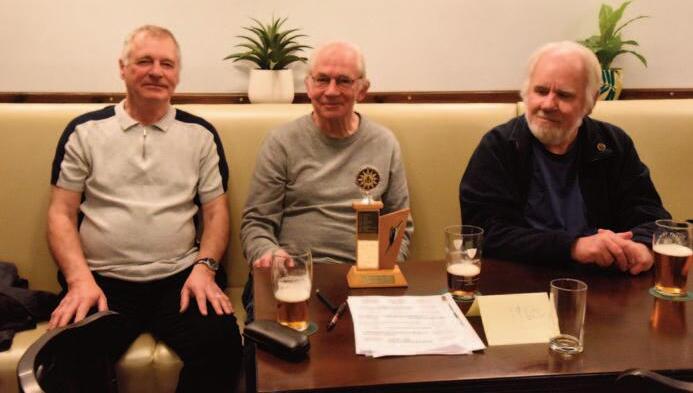
Difficulty: tough
Each row, column and 3 x 3 box must contain the digits 1 to 9
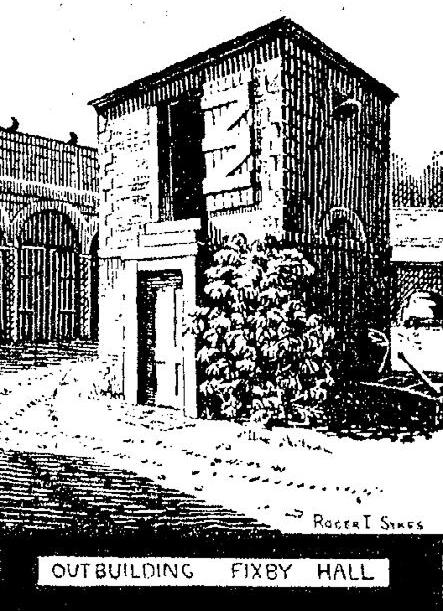
Here was a challenge. What was it? I have discovered quite a few delightful old buildings hidden away in the backyards of farms which reflect development over many years – and sometimes a change of use.
In the backyard of Fixby Hall was this small square building –at the time being surrounded by a carpet of weeds with rather an abandoned look.
I was used to wandering into such places and quite used to asking questions if challenged. After all the column in the Huddersfield Examiner was called ‘In and About’. But this time I had to leave it to the readers.
And so ‘thank you’ to The Almondburian for solving the problem after over seventy years.The Hall is now the home of the Huddersfield Golf Club and the strange square building survives and it covers a well! Partly used as a store, the building is being restored at last. How wonderful that is – I have been rewarded!
l Norris Bonser, who plays regularly at Fixby, adds:
The well was in use until 1950 when corporation water was piped to Fixby Hall.The well was covered and capped only a few months ago.
A second bore-hole was put in use in the 1970s some 50 yds away which feeds a small dam used for watering the golf course.The area around the well was original the stables for the hall and, as seen from the photo was converted for the use by ‘horseless carriages’ in 1920.The photo with the cars was taken at that time and shows the well on the right.
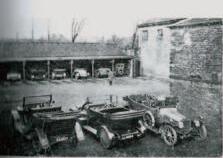
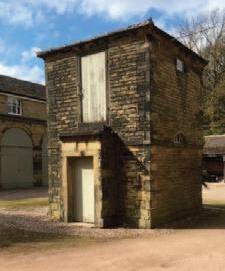
 ANDREW HAIGH
ANDREW HAIGH

Although the badminton season traditionally ends at Easter, it has become something of an Almondburian tradition in recent years to stretch it out until Spring Bank Holiday. It was our intention to do so again this year, but we were unexpectedly thwarted by examinations. GCSE examinations started earlier this year, so that they can be spread out more; the idea being that, if a candidate should succumb to Covid then they might miss one paper in any given subject, but they should be well in time for the second paper. Thus, the sports hall was already full of examination desks by the first Thursday of the summer term. In recent years, there has been one court at the back of the hall clear of desks but, now that the School has expanded, this is no longer the case, so desks would have had to be moved and then replaced in order for us to play.
andrew.haigh@oas.org.uk during the period of external examinations. The move into the new block during the Easter holidays had kept everyone fully occupied and meant that none of this really came to light until the first Thursday of the new term, so the planned badminton session had to be hastily cancelled and the season curtailed.We shall look forward to reconvening in the School sports hall on Thursday, 8th September.
The final nail in the coffin was new examination board rules forbidding lettings
In the absence of an elongated badminton season, we made plans to start the Old Almondburians’Tennis season early, on Thursday, 5th May, once again returning as guests of Longley Community Sports Club, where some of us are members. The start was not terribly auspicious, with only David Parry and I playing the first week and only Neil Gledhill and David Parry playing the second week.The omens were not good for the third week either, when Neil called off with an injury. However, the return of Robin Merchant from exile in Scotland and
the first-time appearance of Sally Starbuck, visiting from Ireland, meant that a ‘phone call home was required to summon reinforcements in the shape of my daughter, Eleanor Haigh, who is currently inYear 10, to make up an even number. Play started as a court of doubles and a court of singles, with players rotating after each game, before we took the opportunity to play a set of mixed doubles and a set of singles. David Parry took on Mark Sykes in the singles, whilst the Haigh family, Andrew and Eleanor, took on Robin Merchant and Sally Starbuck in the mixed doubles.Team Haigh emerged victorious, which I presumed was down to my age and experience, but Robin
left me in no doubt that it was purely because my daughter is ‘a very good tennis player!’
It is some time since the Tennis Section had two courts in play but, unless there is a match on (which is unusual on a Thursday), there are plenty of courts available at Longley, so please come and join us – it is a lovely place to play on a summer evening. There is a guest fee of £3 per week payable by anyone who isn’t a member of Longley Community Sports Club and we pay an additional £2 per week to the O.A.S. to cover the cost of balls and, if we use them, floodlights. Afterwards, we retire to Almondbury Conservative Club for refreshments. n
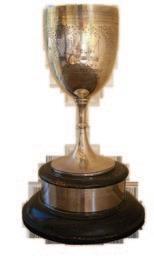 ROBIN MERCHANT robin.merchant@oas.org.uk
ROBIN MERCHANT robin.merchant@oas.org.uk

MANY congratulations to Mark Slater (right), winner of the 2022 Gothard Cup competition which took place at its traditional venue of Woodsome Hall on Sunday, 12th June.
Woodsome in good but tough condition, particularly the rough. More about that later.
It was a great result for Mark Slater as he was playing in his first Gothard Cup and for Andrew Douglas whom we welcomed back after not playing for far too many years. Let’s hope this is the start of something with more new faces next year.
Mark Slater (33 points)
l 2nd place
Andrew Douglas (31 points)
l Best front 9
Nine Old Almondburians were joined by Michael Blakey, who is now considered an honorary OAS member. The OAS players were Robin Sharman, Mark Slater, David Parry, Simon Russell, Richard Brown, Jon Roberts, Tim Roberts, Andrew Douglas and myself.
We were blessed with good weather and we all found
Richard Brown (13 points)
l Best back 9
Tim Roberts (17 points)
The other prizes were originally to be nearest the pin at the par 3 10th in one and nearest the pin at the par 4 17th in two. A stipulation was that one’s ball had to be on the green to count! Unfortunately, no-one

managed to get on either green, so some alternative prizes had to be quickly devised! The scoring on the front 9 was poor but Richard Brown with 13 points was the winner. Tim Roberts was a more convincing winner of the back 9 mainly by virtue of an eagle at the 16th with a shot giving him an impressive 5 points.
A special prize for valour was presented to Jon Roberts who on the 11th found the heavy rough (or should I say jungle). His playing partners were initially impressed as he managed to hack out but on looking back were dismayed to see Jon on the ground in severe pain. He had damaged his hand, sadly breaking a couple of bones. Despite this Jon decided to play on and completed the round, even though his hand was already swelling up and turning a nasty shade of blue.
Following the golf, we enjoyed an excellent meal and many thanks must go to Woodsome for again providing a great venue for our competition. Many thanks also to Simon Russell, who made all the arrangements with the Club.
Another big thank you must go to Richard Brown, who – as promised last year – provided a wonderful bottle of vintage port, which was enjoyed by all with our cheese and biscuits.
We again collected £25, for a School Prize which will be presented to the pupil with ‘the best sporting achievement outside School’.
Next year’s Gothard Cup competition is planned for mid-June 2023 so if you think you might enjoy some good company mixed in with some golf– and possibly another glass of Richard’s vintage port – do try and join us. n
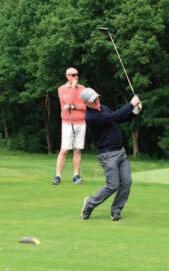


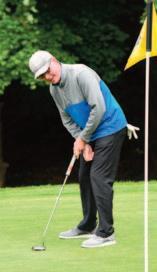

Iwas deeply saddened to learn of the recent death of Christine Hazle (Obituary: page 63) . Christine was my friend and work colleague for nearly 40 years, during which time I witnessed first-hand the inner steel which belied this amazing woman, with her calm appearance and demeanour coupled with her quiet, but total, control of her classes. She was, without doubt, a force to be reckoned with.
A strong believer in lifelong learning, she was at the forefront of all the latest education initiatives, embracing change whilst cherishing and paying respect to the past. She was fastidious in all things textile-related. I recall on more than one occasion, she insisted I brought the entire class back at break time to search for a sewing machine needle that had disappeared.
I was introduced to the OAS by Christine in the days when we would organise 6th Form students to act as waiters and waitresses at the Annual
Dinner. Standing quietly in the background, she would orchestrate an army of around 20 students to expertly serve meals to around 160 diners. It was through this experience that many of those students went on to join the Society.
Christine was gifted, creative and extremely talented. The Christmas card I received this year bore the footnote “from a watercolour by Christine Hazle” and a ‘Christine Hazle original’ watercolour of Holmfirth adorns our living room wall. She would turn up at our house and spot two vases of halfdead flowers, two minutes later she would re-appear from the kitchen with something resembling an Interflora display.
A truly inspirational mentor and friend, we are poorer for her loss but richer for the many happy memories and the legacy she has left in our lives.
Angela Mellingl Christine’s watercolour of Holmfirth mentioned above is on page 3.
We are always delighted to receive articles, letters or photographs for publication in The Almondburian. Photographs should ideally be at 300dpi resolution at the size at which they will appear in the magazine, and in .jpg or .png format.
Editorial email address: almondburian@oas.org.uk
Almondburian with a passion for the history of the Huddersfield textile industry
Keith Brier entered King James’ Grammar School from Deighton Primary School in September 1947 and was in the same form as his cousin Ian Clelland (now living in Phoenix, Arizona). He left in July 1952 to start an apprenticeship in the flourishing Huddersfield textile industry: he studied textile manufacture at Huddersfield Technical College, leaving with an ATI (Associate of Textile Institute).
Keith worked for several Yorkshire textiles companies before starting, with his wife Margaret, a new niche weaving business Thorn Bank Tweeds. They jointly ran the business for 15 years before Keith took up a senior role in a Galashields textile company before finally returning to Yorkshire as Mill Manager at Taylor and Lodge in Lockwood from where he retired.
Keith’s passion for the textile industry led him and Margaret, whom he had married at Golcar Parish Church in 1960, to open a living working museum at Upperthong to ensure that the craft skills of the industry were never forgotten
Keith and Margaret had five chidren. The family spent many happy days camping and, after building his own dinghy, sailing near York.
Throughout his life Keith was passionate about jazz, Big Bands and steam trains. As a young man Keith went with his friends to the Isle of Man to hear the big
bands of Joe Ross and Ronnie Aldrich at the Palace Ballroom. At his funeral the music of Count Basie, Duke Ellington and Benny Goodman was a poignant and happy memory of Keith’s passion for jazz.
In retirement Keith and Margaret enjoyed travelling around Europe, Egypt, Hong Kong and Australia. Unfortunately this had to stop when Keith was diagnosed with Alzheimer’s in 2018.

Our class of 1947 met annually for a beer, food and to talk of the ‘good times’. Keith will be sadly missed but it was a life lived to the full and we are all better for having known him. Keith’s exit music from the funeral service was Bring me Sunshine – he certainly did!
Keith Brier, born 27th June 1936, died 27th February 2022 aged 85.
Norris Bonser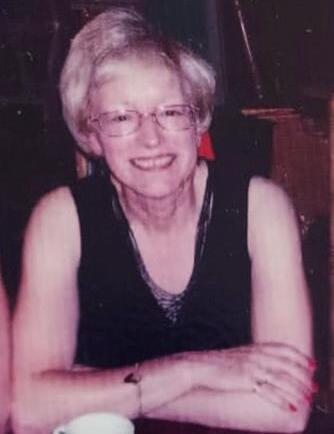
Christine Hazle played a key role in the transition of King James’s from a boys’ Grammar School to a thriving Comprehensive by working with Chris Temperton to build an enormously successful Technology Department. Christine, by her leadership and her own high teaching standards, developed an outstanding team of teachers who provided courses in Textiles and Food Technology that students loved to follow. At option choice in Year 9 the GCSE courses her team offered were invariably over subscribed by students, a reflection of the energy and fun she and her staff put into their subject. She led this team for 23 years until her retirement in 1999.
Christine was born in a snowy Halifax on Tuesday 21 January 1941. She had an older sister, Margaret, and they would share the same home until Margaret had to go into a nursing home in 2014.
Christine did not initially train to teach: on leaving school she entered the world of work at Ollerenshaw’s Sewing Thread manufacturing company, later joining Fleming, Birkby and Goodall, manufacturers of boiler suits and Kumficar Ltd, seat cover makers.
During her time in work she was forever gathering qualifications in the textile areas she loved. Christine achieved City and Guilds qualifications in Dressmaking, Soft Furnishings, Upholstery and later Food Technology.
She was an outstanding practitioner herself but felt she wanted to pass on her personal skills so in 1967 she began a Teacher Training course at Huddersfield College of Technology (now the University).On qual-
ifying in 1968 she was appointed to Holmfirth High as a Textiles teacher where she spent the next eight years developing and honing her teaching and organisational skills which she was to use with such effect at King James’s.
Besides running a very successful department she played a full part in the broader life of School. During these early years of the comprehensive there was a particularly vibrant Performing Arts Department. This resulted in drama and musical productions being staged every term and Christine quickly became involved. Her expertise in dress design was evident in the drama productions as she helped with costumes for the cast. Many of the productions involved parents watching from beautifully decorated tables as food and drinks were served. As usual Christine was heavily involved.
Later Christine and Angela Melling became involved in the School Careers Evenings.These would involve 30 or 40 different industries being represented in School for students to ask questions about the ways to enter that career. Christine and Angela organised teams of students to cook food for all the people before the evenings began. The quality of food cooked and service given led to many of the exhibitors saying that this was the Careers Evening they made sure they never missed. As with all things Christine organised, the Careers Evenings were a massive success.
Similarly Christine was a great supporter of the OAS. In the days up to 1990 when King James’s still had a Sixth Form she took on the responsibility of organising sixth formers to serve at the Annual Dinner in School. She also decorated tables with beautifully folded napkins and floral arrangements: small touches which further enhanced the evenings.
In School Christine enjoyed and welcomed new technology whilst many of us were reluctant to take on board all the new initiatives. This enthusiasm for change was noticed by the Head (then Clive Watkins) and he gave her a lead role in developing the skills of all the staff. She took on the role of Technical Vocational Educational Initiative (TVEI) organiser. (TVEI had been set up by the Government to develop new IT skills in schools). It was the beginning of the age of the computer in schools and Christine loved it! For five years money was made available to improve and develop teaching skills in this area and Christine led from the front.
At this same time she completed a three year part-time honours degree at Bradford University. Later she was to gain a Masters
degree as well as specific subject based qualifications such as Silversmithing and becoming a member of the Embroiderers’ Guild.
Every summer during her teaching life Christine and her sister went on holidays all round the world and she used the opportunities to bring back samples of work from local people to show students and use in displays. They visited Australia, New Zealand and many areas of South America including a visit to Machu Picchu in Peru which was a personal favourite.
In 2003 she met another keen traveller, Charlie Alwyn Clarkson and they began a loving relationship which lasted until his death in 2019.Their travels continued with a particularly enjoyable trip to China though in their enthusiasm to try to see everything they agreed they had exhausted themselves and perhaps needed to take things more leisurely in future.
On starting at King James’s Christine and her sister had moved to Thongsbridge where they lived next door to another King James’s legend, Doreen Hinchliffe and they began a long friendship. Later Doreen moved into Holme Valley Court in Holmfirth. Christine’s sister died, after a long illness, at the age of 87 in 2016. Doreen and Christine continued their long friendship and so when Doreen died a couple of years ago it was no surprise she bought the former home of her good friend. She moved into the flat in 2020 and loved being in the centre of Holmfirth.
Her life continued at a pace. She joined the U3A, Probus and Phoenix and had holidays booked for later this year in the Isle of Wight and on a cruise in the South of France.
Christine attended her last OAS Dinner in November and was a joy to talk and rem-
inisce with. It was also wonderful that evening to see many women members wearing their OAS scarves. You may remember it was Christine who pushed the Society to have something for women members to wear at social functions. She took on the project and designed a silk scarf using the stained glass window in the Big as the basis for her design.Yet another legacy she has left.
It was a shock to all to find she had such a serious illness which took her from us far too quickly. She was taken by ambulance to
the Renal Unit in Leeds and despite exemplary care died there peacefully on Ward 51 at St. James’s Hospital on 2nd March. Her funeral was both incredibly sad but also a great joy. So many of her old friends and colleagues came along and spoke of what an inspiring person Christine was to us all. It was fitting that her old friend and former colleague Rev Pat Reid lead the Service in the Crematorium.
Ann Turner andWalter Raleigh Christine Hazle born 21st January 1941, died 2nd March 1922 aged 81.
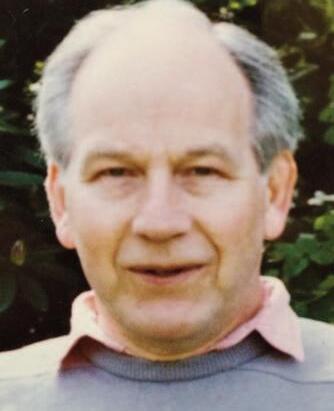
Polish refugee who taught Chemistry at KJS and helped found local geology group
Andrew Krasinski’s beginnings were far from Yorkshire. When World War II broke out in September 1939 and the Germans invaded Poland, he was a child aged 2 living with his parents in Warsaw. His father, Hubert, was an aeronautical engineer and a Major in the Polish Air Force: he and his wife, Irena, packed their car with Andrew and a few essential items, including the family photograph albums, and fled east and south before the advancing Nazi troops.
The family travelled fast, through Romania, Yugoslavia, Italy and France but the journey still took a month. Eventually Hubert had to rejoin his Polish Air Force comrades in England and leave his family in St. Jean-de-Luz, in south-west France. Andrew’s twin brother and sister, Teresa and Kris, were born near here in 1940, and mother and children spent the rest of the war in relative safety in various parts of France. Andrew’s memories of this childhood were
naturally sparse, but he always remembered his six times table in French, because that was how he learned it.
By May 1946 the War was over, Hubert had rejoined his family, and together they all moved to England. Here Hubert, who had good English, taught
en gineering in technical colleges and they lived in various parts of the UK including Bradford: Andrew recalls his school teacher here calling a special register on Mondays to check that all been to Mass the previous day, and also having to fight the other boys because he was Polish. He had a pen-knife scar from that time.
Around 1950 he went to Ampleforth College, a formative influence on the rest of his life. He did well enough in his studies to go on later to university, but he also learned and enjoyed rugby union and rifle-shooting, which he continued at university. As a young man, he had exquisite italic writing taught to him by the Benedictine monks in what seems like a direct line from mediaeval monastic scriptoria. One of his sorrows in old age was that a tremor in his hands made it impossible to write clearly any more.
In 1956 he began a BSc course in organic chemistry at King’s College, University of London; it was here that he met his future wife Bridget who was studying English Literature
By 1962 Andrew needed a job and came to Huddersfield to work for ICI as an industrial chemist, and in 1965 he married Bridget and they set up home together in Marsh. Emma and Joseph were born in the next four years, and life was very happy. But the work with ICI ended in 1973: so Andrew took up a new career teaching chemistry in
King James’ School, Almondbury where his pupils remember him affectionately, while Bridget joined the staff at the new All Saints’ Comprehensive School. We moved to Birkby in 1975, to a house with plenty of space and a large garden which was gradually adorned with geological specimens as well as pots of lilies.
A heart attack in 1988 ended his fulltime teaching career and after some gentler teaching commitments he retired in 1991. He joined local geology evening courses and was a founder member of the Huddersfield Geology Group in 1993. With this group he travelled on expeditions all over the UK and also Nova Scotia and Iceland. Family holidays in France and the UK were chosen not only for cathedrals and sunshine but also for geological marvels such as deep caverns and extinct volcanoes.
Four grandchildren, whom he loved dearly, arrived in 2003 and 2005.
Although Andrew developed more and more infirmities from old age and became increasingly confined to his armchair and TV, he never complained about his disabilities. His final decline this summer was swift: but he was able to die peacefully at home, looked after by those whom he loved and who loved him.
Bridget Krasinski
Andrew Krasinski born 4th April 1937, died 14th August 2021 aged 84.
We are also saddened to learn of the death of Pam Breeze, who was a valued former member of the office staff at King James’s School.




A History of King James’s Grammar School is the official history of the School covering the period 15471963. The author of this 284 page hardback full of reminiscences and anecdotes was historian and former KJGS pupil Gerald Hinchliffe.
£10 plus P & P
Morning Assembly gives a fascinating and often humorous account of former Headmaster Harry Taylor’s life and includes, in facsimile form, 100 prayers –ancient and modern – which he assembled over the years for use in School assemblies.
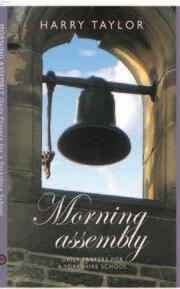
£10 plus P & P
An Illustrated History of King James’s School in Almondbury was originally published to mark the 400th anniversary of the Charter in 2008. A full colour hardback recording 400 years of history, packed with illustrations throughout.

£10 plus P & P
No beating about the Bush is the final year diary of former deputy head Dave Bush, who retired in 1996. A detailed day-today account of life at King James’s School with detailed and often amusing accounts of school life 25 years ago.
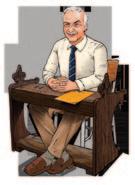
£15 plus P & P
If you prefer to pay by cheque, please make it payable to the Old Almondburians’ Society and post it to Andrew Haigh, R D Haigh & Co, Oakhill Road, Brighouse, West Yorkshire HD6 1SN.
Chairman
WALTER RALEIGH
15 Thorpe Lane, Almondbury HD5 8TA Tel: 01484 308452
Email: walter.raleigh@oas.org.uk
Secretary
ANDREW HAIGH
2 Arkenley Lane, Almondbury HD4 6SQ Tel: 01484 432105
Email: andrew.haigh@oas.org.uk
Treasurer
KEITH CRAWSHAW
5 Benomley Drive, Almondbury HD5 8LX Tel: 01484 533658
Email: keith.crawshaw@oas.org.uk
Media Editor
ROGER DOWLING
Orchard House, Oughtrington Lane, Lymm, Cheshire WA13 0RD
Tel: 01925 756390/07815 601447

Email: almondburian@oas.org.uk
Assistant Media Editor
RICHARD TEALE
The Sycamores, 239 Huddersfield Road, Thongsbridge, Holmfirth HD9 3TT Tel: 07810 313315.
Email: richard.teale@oas.org.uk
KJS Representative
ABBIGAIL TERRY
King James’s School, St Helen’s Gate, Almondbury HD4 6SG Tel: 01484 412990
Email: abbi.terry@oas.org.uk
Website: www.oas.org.uk
The Almondburian is distributed to OAS members free of charge. Price to non-members: £3.00